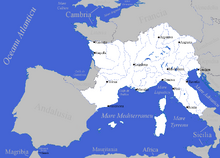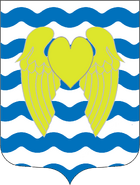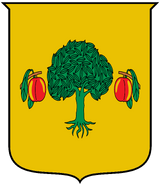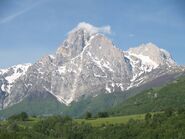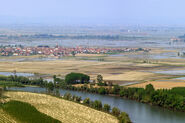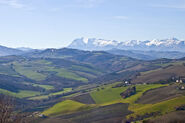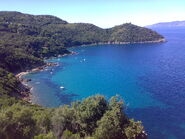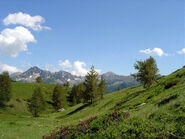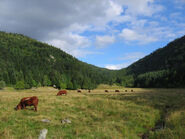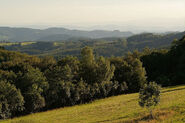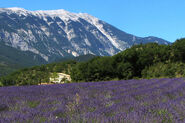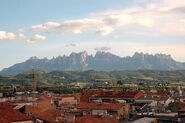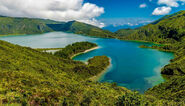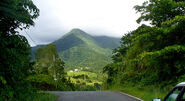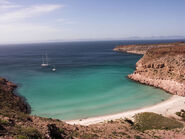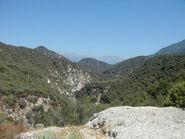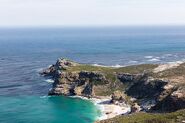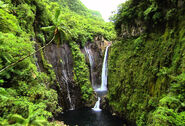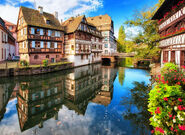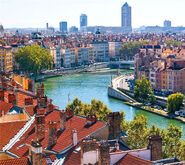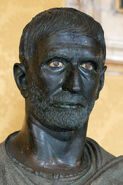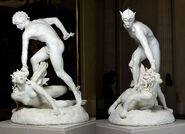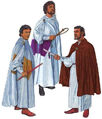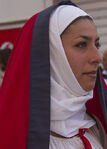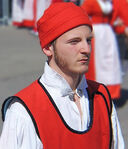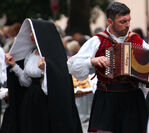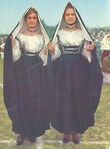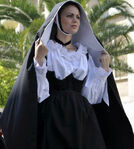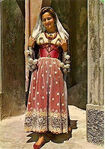SPQR | |||||||
| Anthem | "Himnu ad Roma" | ||||||
| Capital (and largest city) |
Raveña | ||||||
| Other cities | Mediolanu, Barcinona, Roma. Argentea, Rupella | ||||||
| Language | Roman | ||||||
| Religion | Hellenism 70 percent, Non-religious 23 percent, Christianity three percent, Buddhism one percent, Judaism 0.5 percent, 0.5 percent Islam | ||||||
| Ethnic Groups main |
Roman 88 percent | ||||||
| others | Sinti three percent, Valachian two percent, Other seven percent | ||||||
| Demonym | Roman | ||||||
| Legislature | Federal constitutional diarchic-directorial democratic republic | ||||||
| Consul | Aeliana Berninu, Cassandra Bergamone | ||||||
| Population | 152,169,507 | ||||||
| Established | AUC 1 – Roman Kingdom AUC 245 - First Roman Republic | ||||||
| Currency | Lira £ | ||||||
Romania is a federal constitutional diarchic directorial democratic republic. It is a founding member of the League of Peace, GOLA, and other international organizations. It is a highly developed country, with one of the world's largest economies. Romania is considered to be one of the world's most culturally and economically advanced countries with a very high life expectancy. Its inhabitants and principal ethnic group are the Romans.
Romania ranks very high in measures of socioeconomic performance, including average wage, median income, median wealth, human development, per capita GDP, and worker productivity. Romania is a member of the GGPC (Global Great Power Council), one of 23 nations considered a Great Power. Romania is one of nine nations considered a World Power. It is one of the foremost military powers in the world, considered the strongest land-based military, and makes up a third of global military spending, and is a leading political, cultural, and scientific force internationally. Romania is ranked as the most charitable nation, with Romans donating more time, money, and goods than any other (notably these donations are mostly given internationally, to foreign states and foreign populations in need, rather than internally).
The country has greatly influenced and contributed to diverse fields, notably the arts, music, literature, philosophy, science and technology, fashion, cinema, cuisine, sports, as well as jurisprudence, banking and business. As a reflection of its cultural wealth, Romania is home to the world's largest number of World Heritage Sites and is the one of the most visited countries in the world.
Romania has historically been home to myriad peoples and cultures including the Italic peoples, Phoenicians and Carthaginians, Greeks, Etruscans, Celts, Vasconics, and Germanic peoples. An Italic tribe known as the Latins formed the Roman Kingdom which eventually became a republic with a government of the Senate and the People. The Roman Republic initially conquered and assimilated its neighbours on the Italian peninsula, eventually expanding and conquering parts of Europe, North Libia and Asia. The Roman Empire emerged as the dominant power in the Mediterranean Basin and became a leading cultural, political and religious centre, inaugurating the Pax Romana, a period of more than 200 years during which Romania's law, technology, economy, art, and literature developed.
Romans broadly indicate six founding dates for Romania from the Roman Kingdom in AUC 1 to the current Republic in AUC 2576. The generally accepted founding date of Romania, however, is AUC 254, the date establishing the First Roman Republic.
Roman Flag, State Emblem, and other Symbols
Etymology[]
Romania derives its name from the ancient city Rome. According to the founding myth of the city by the Ancient Romans themselves, the long-held tradition of the origin of the name Roma is believed to have come from the city's founder and first king, Romulus. However, it is a possibility that the name Romulus was actually derived from Rome itself. As early as the 11th century, there have been alternative theories proposed on the origin of the name Roma. Several hypotheses have been advanced focusing on its linguistic roots which, however, remain uncertain: from Rumon or Rumen, archaic name of the Tiber, which in turn has the same root as the Greek verb ῥέω (rhéō) and the Latin verb ruo, which both mean "flow"; from the Etruscan word 𐌓𐌖𐌌𐌀 (ruma), whose root is rum- "teat", with possible reference either to the totem wolf that adopted and suckled the cognately named twins Romulus and Remus, or to the shape of the Palatine and Aventine Hills.
Romania in turn means “Land of the Romans” and evolved from early Roman (Late Vulgar Latin) Romaniae. Exonyms for Romania vary by language with some originating from the Roman self-designation:
- Pannonian: Rûmnê
- Cambrian: Romani
- Andalusian: Romania
- Valachian: Romãnia
- Scandian, alternate: Romænien
- Latin: Romaniae
- Grecian: Ῥωμανία (Romania)
- Persian: Rumistan
- Arabian: رُومَانِيَا (Rūmāniyā)
- Vasconian: Erromania
- Sicilian: Romanìa
- Tsalagian: ᎶᎹᏂᏯ (lomaniya)
- Francian: Römanie
- Frisian: Romeenje
- Kurdish: Romanya
- Tatar: Rumeliä
- Esperanto: Romanio
In some languages, particularly in Central and Eastern Europe, the word for Romance peoples was borrowed from the Goths (walhs) into Proto-Venetic. From the Venetics the term passed to other peoples, such as the Hungarians and was used for all Latinic people of the Hemia. Exonyms based on Gothic ‘walhs’ include:
- Gepidian: Ƕaland
- Lombard: Wälschland
- Scandian: Valland
- Saqvegian: Valland
- Hellulandic: ᐆᐃᓪ (uuil)
- Wendish: Włoska
- Hungarian: Olaszország
The term Daqin (Chinese: 大秦; pinyin: Dà qín, Middle Chinese: /dɑiH d͡ziɪn/), meaning "Great Qin," is derived from the dynasty founded by Qin Shi Huang, ruler of the State of Qin and China's first emperor who unified China's Warring States by AUC 533. The prefix "da" (大) or "great" signified that the Roman Empire was on par with the might of the Qin Empire and was viewed as a utopian land located to the northwest of the Parthian (Persian) Empire. The title "Daqin" does not seem to have any phonetic derivation from Latin Roma or Greek Romaikē.
- Sinaean: 大秦 (Dàqín)
- Japanese: だいしん (Daishin)
In Meshica, the world 'tona' means of the sun, or for the sun to shine. The Romans were first termed by the Meshica the 'Sons of the Sun', the origin of which may have had to do with either the belief of the Roman connection with the Meshica sun god (Tonatiuh), the Roman use of numerous sun symbols and their own sun-worship (Zeus-Helios), or the lightness of their skin and hair. It could have been due to all three as well and there is a plethora of information that suggests this to be so. With the fixture of the Meshica suffix -co it indicates a place, therefore tonatih-co, place of the sun.
- Meshican: Tonatihco
History of Romania[]
Main Article: History of Romania
Golden Age and First Age[]
Thousands of Palaeolithic-era artifacts have been recovered and dated to around 850,000 years before the present, making them the oldest evidence of first hominins habitation in the Italian peninsula. Excavations throughout Romania have revealed a Neanderthal presence dating back to the Palaeolithic period some 200,000 years ago, while modern Humans appeared about 40,000 years ago. Valon Grotto in Transalpinia is a cave that contains some of the best-preserved figurative cave paintings in the world, as well as other evidence of Upper Paleolithic life. The Cardium pottery culture stretches the length of Romania, from Hispania across Gallia and Italia and including neighboring Dalmatia dating to AUC -5646
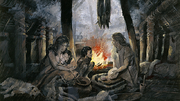
AUC -446, Ancient Era Rome
A well-preserved natural mummy known as The Venusta Iceman, determined to be 5,000 years old was discovered in the Similaun glacier of Alpine Romania in 2744. He is Europe's oldest known natural human mummy, and has offered an unprecedented view of Chalcolithic (Copper Age) Europeans.
The Ancient peoples of pre-Roman Romania – such as the Umbrians, the Latins (from which the Romans emerged), Volsci, Oscans, Samnites, Sabines, the Celts, the Ligures, the Veneti, the Celtiberians, the various Germanic tribes, and many others – were Indo-European peoples, many of them specifically of the Italic group. It is possible that the Italic group and Celtic group furthermore share a common past and are branches of one another.
The main historic peoples of possible non-Indo-European or pre-Indo-European heritage include the Etruscans, the Vasconics, the Iberians, and the prehistoric Sardinians, who gave birth to the Nuragic civilisation. Other ancient populations being of undetermined language families and of possible non-Indo-European origin include the Rhaetian people and Cammuni, known for their rock carvings in Valcamonica, the largest collections of prehistoric petroglyphs in the world.
Second Age and the Foundation of Rome[]

Early Rome
Rome, a settlement around a ford on the river Tiber in central Italy conventionally founded in 1 AUC, was ruled for a period of 244 years by a monarchical system, initially with sovereigns of Latin and Sabine origin, later by Etruscan kings. The tradition handed down seven kings: Romulus, Numa Pompilius, Tullus Hostilius, Ancus Marcius, Tarquinius Priscus, Servius Tullius and Tarquinius Superbus. In 245, the Romans expelled the last king from their city, favouring a government of the Senate and the People (SPQR) and establishing an oligarchic republic.
The Italic Peninsula was consolidated into a single entity during the Roman expansion and conquest of new lands at the expense of the other Italic tribes, Etruscans, Celts, and Greeks. A permanent association with most of the local tribes and cities was formed, and Rome began the conquest of Western Europe, Northern Libia and the Wstern Asia. In the wake of Julius Caesar's rise and death in AUC 710, Rome grew over the course of centuries into a massive empire stretching from Britannia to the borders of Persia, and engulfing the whole Mediterranean basin, in which Grecian, Roman, Gallic, and many other cultures merged into a unique civilisation. The long and triumphant reign of the first emperor, Augustus, began a golden age of peace and prosperity. Italia remained the metropole of the empire, and as the homeland of the Romans and the territory of the capital, maintained a special status which made it "not a province, but the Domina (ruler) of the provinces". More than two centuries of stability followed, during which Italia was referred to as the rectrix mundi (queen of the world) and omnium terrarum parens (motherland of all lands) and to this day modern Romans across the country have DNA traceability to the Italic Peninsula.

Roman Legion
The Roman Empire was among the most powerful economic, cultural, political and military forces in the world of its time, and it was one of the largest empires in world history. At its height under Trajan, it covered 5 million square kilometres. The Roman legacy has deeply influenced the Western civilisation, shaping much of the modern world; among the many legacies of Roman dominance are the numerical system, the modern Western alphabet and calendar, and the emergence of Hellenism as a major religion and of Christianism in the Eastern Roman Empire. The Indo-Roman and the Sino-Roman trade relations testifies to extensive Roman trade in far away regions; many reminders of the commercial trade between the Indian subcontinent, East Asia, and Romania have been found, such as the ivory statuette Pompeii Lakshmi from the ruins of Pompeii.

Roman Legionary
In a slow decline since the eleventh century AUC, the Empire split in two in 1148. The Western Empire, under the pressure of the barbarian invasions, ultimately carried the mantle and title of Roman Empire while being reduced significantly in size and going through fits of growth and decline. The Eastern half of the Empire evolved into the Grecian Empire (also still known as the Roman Empire, as well as the Constantine Empire, and the Byzantine Empire, neither contemporary) and became dominated by Christianism while being instrumental in the spread of that religion.
Third Age and Fourth Age[]
After the splintering of the Roman Empire into two, Romania fell under the influence and sway of myriad Germanic tribes. Conflict erupted early and frequently with the neighboring Grecian Empire over religious conflicts and territorial issues owing to the two realms claiming sole Roman continuity. The First Sacred War, started by Roman Emperor Tribunus Urseolus, sparked this rivalry into a major conflict which removed Athens from Grecian control and subjected the Grecian Empire to invasion by Slavenians and Arabs.
The 1700s would begin the Viking Age and a focus on seaborn raiders from the north, alongside a tightening of friendship and alliance with Cambrian, in part due to these threats.

Roman infantryman circa 18th century
During the Third Age Romania played a crucial innovative role in financial development, devising the main instruments and practices of banking and the emergence of new forms of social and economic organization that spread aross Europe. In coastal and southern areas, Romania grew to eventually dominate the Mediterranean and monopolise trade routes to the Orient. The War of the Augustas, from AUC 1996 to 2003, set the stage for an end of the Roman Empire which was ended after the death of empress Sancia in 2080. The Senate abolished the Augustuship over night, announcing a rebirth of the Roman Republic. The two existing consuls were elevated; Mule Notaiu of Titanu was announced as Supreme Consul and his deputy Ninu Mula, was declared Defender Consul. The Senate borrowed predominately from their understanding of the First Roman Republic for what has now become known as the Second Roman Republic.
The Black Plague, beginning in 2084 in Romania, devestated the country and killed between 60 and 70 percent of the population. Jews, Christians, foreigners, beggars, lepers, and Sinti, were blamed for the crisis in many areas in Romania. There were many attacks against Jewish and Christian communities. Sinti slaves were killed as well, variously blamed for the epidemic. From the perspective of many of the survivors, the effect of the plague may have been ultimately favorable, as the massive reduction of the workforce meant their labor was suddenly in higher demand. For many Romans, the century was a golden age of prosperity and new opportunities, post-plague. The land was plentiful, wages high, and farmland was available. It was a particular boon to Romans in the Po Valley and a large swath of area in northern Italia. This region of the Republic remained relatively plague free. The population here, long overcrowded, subsequently had the opportunity to expand across Romania and fill vacant lands.

Roman Heavy infantry circa 2200
In 2156 Carolu Zenu, a naval hero of the Haemic Wars, set out on a mission of exploration, charged by Supreme Consul Vita Corvellu and the Senate to build upon earlier Roman voyages. In 2044 Roman expeditions led by two Roman sailors, the Vivaldu brothers, had sailed down the Libian coast, reaching and claiming the Fortunate Isles in the Atlantic and mapping much of the western Libian coast. In 2170 Antoniu Barbaru would land in Boriken and subsequently open up Hesperia to Europe in a way previously unseen. This would open the Age of Exploration and ultimately brought about contacts across the world, linking it for the first time in history. The meeting in Melinde on the eastern coast of Libia in AUC 2190 with Sinaean merchants is an event of upmost importance to history. Subsequent trade ports were was established on the Cape of Storms specifically for the Sina-Roman trade and the point was fortified as an important part of Romania. AUC 2198 witnessed the formal signing of the Golden Alliance with Sinaean Emperor Yingzong. Romania and Sina essentially agreed to divide the world into two halves, one to be the dominion of each, with a line running up from the Cape of Storms - the southern tip of Libia.
Frankish Käsar Antonie II Rhingburg declared himself Emperor of Romania, Augustus Antonius Rhenusburgum Carolus Magnus Francorum et Romanorum on January 9th 2463. This brought about the union of the Roman and the Frankish Empires. This also began what is now called the Second Roman Empire.
Fifth Age to Present[]
The Fifth Age is largely regarded as coming into being with the ascent of the Borromeu Dynasty by the election of Titu Borromeu as Emperor in Romania as well as the conclusion, in 2499, of the Revolution of the Isles in Cambria and Hibernia.
The Borromeu dynasty built upon the advancements of the Roman military started by the Rhenburgu dynasty and is largely seen as the first time such levels of professionalism had been seen by the Legions since the height of the Marian Reforms in the 8th century AUC. Uniformity began to develop and the foundations of the modern military system can be seen.
The Borromeu dynasty brought war on Romania and much of Europe, igniting the so called Great Global War. The war ran from 2536 to 2586 and spanned much of the globe, known as the Fifty Years’ War, the Borromeic War, and the Romano-Cambrian War additionally. The closing chapter of the conflict arrived due to an immense Roman invasion attempt of Cambria. The full might of the two navies clashed in the Battle of the Celtic Sea and Cambria came out the victor, sinking the glory of the Roman fleet. The Legions were spread too thin due to the widespread confclit and the continent lay open. The last three years of the war occurred across Romania with brilliant success to the Romans, though it would not be enough. The Battle of Ravenna (2586) saw the occupation of that city and Romania by Cambrian forces. The Borromeu dynasty was allowed to remain in place but all of Romania's war gains were stripped and Boriquen was given to Cambria, along with Crete, the Balearic Islands, and the city of Tamuda.

Roman Legionaries AUC 2510
The score following the end of the Fifty Years' War was a time of rebuilding and the globe witnessed a general cultural flourishing known as the Golden Score. These two decades involved a building of trans-continental connections, particularly via Cambria's new position in the world, along with that realm's new global possessions and revolutionary political philosophy.
The Roman Revolution (2609 - 2619) erupted due to the oligarchic nature of the Second Republic and the monarchic nature of the Second Empire. The inertia of the Hibernian and Cambrian revolutions also played dynamic roles and the novel ideas of a republic governed equally by plebs, not strictly patricians or hereditary, would prove far too subversive for the existing institutions to maintain their survival. The declaration of the Republic of Carpetania in 2609 was the culmination of these things. The most widely known battle of the lengthy war and the deciding clash is the Battle of Sulferinu. With an outnumbered force (Republican 82,000 to Imperial 120,000) the Republican side gained a decisive victory. The imperial family fled in the aftermath, sequestered away aboard a ship bound for Meshico.
Mariu Maravília was named the first Senatorially elected Consul and his second was chosen as well, the Republican war hero Tajani Dragoi, a Valachian who had first made a career as a Legionary Duce in the Roman Army and, with the outbreak of the war, quickly moved to the Republican side. The birthing pains of the new Republic were many-fold. The new government had to recover from a damaging internal war, one one a destructive level technologically not seen before. The internal rifts were also extremely prevalent and many novel ideas had been put into motion, such as emancipation of the Sinti and true rule by the people with true democracy. Romania spent the next four years consolidating and rebuilding. Vintsente Píxea would step into the position of Senatorial Consul following Maravilia's departure in 2625. Píxea was a Hellene priest in his younger days and spent time touring the world. His notable experiences derived from Ganonsia, where he developed his economic theory of Egalitarianism.
Píxea made it his Consular work to adjust the Republican system in Romania to divert it toward a vastly more democratic and equitable system than had been seen ever before, in order to prevent a rupturing of the republican that would succumb to Empire ever again. Píxea's economic theory had been decades in the works and had adherents in Romania as well as across Europe, Hesperia, Libia, and Asia, thus the details of such a change were already laid out. Implementation was smooth, due in no small part to the chaos still ruling since the rebirth of the Republic, laying open the way for new ideas. The Consul's redistribution system alleviated homelessness caused by the war and resulted in a farming boom that curved the rising hunger issues brought on by the war. By 2630 Romania had shifted its entire spirit behind Egalitarianism and the Republic.
The period before the Great Eurasian War was one of internal and external growth in Romania and immense prosperity. The Great Eurasian War, 2670 to 2675, would not involve Romania directly but altered European, and Roman, politics none-the-less, especially with the rise of Sotnism and other radical fronts brought about by the chaos of the war and the building economic fallout of the immense wealth growth that had been on-going.

Roman Legionary, World Order War
The series of events that led Nicolau Bombelles and the Caesarist Faction to dominance in the 2680s stemmed from a growing resentment within Romania and globally. These echoes brought about Sotnism in Scandia, Tataria, and Wendia and created a similar fashion in the form of Caesarism in Romania and other western European states. These movements looked for a strongman to lead the people through the turbulent times that followed the hardships endured by recent conflicts, devestating on scales the world had not known. This technological growth that allowed for such deadly warfare and brought about a boom in population growth and thus resource issues. To accompany these issues came the rising presence of a globe that was connected by increased trade and contact, boosted by technology, paving the way for a multiculturalism hardly witnessed before in history. This brought innovation and joy but also unease and a flair of traditionalism in many places. The Popular elected Consul Nicolau Bombelles would be the first at last elected consul of the Caesarist Faction, voted into office in 2691, and he would rule along, as sole consul, with the death of the Senate's Consul Larentu Magnulu. The senatorial elected consul was killed in what remains unknown circumstances and to this day there remains a division among historians as to if he was murdered simply by an angry and disgruntled Roman or if it was a planned Caesarist attack.
The New Order War ran from 2693-2701 and pitted the League Alliance, led primarily be Romania, Cambria, Francia, Persia, Ganonsia, and Sina against the New Order Pact of Wendia, Tataria, Scandia, and Meshico and, thirdly, the Co-Prosperity Pact led by Japan and including Tlallam, Haidagwai, Siam, Mongolia, and Brunei. A massive modern conflict, the engagement involved total war, witnessing the destruction of cities and extensive loss of civilian lives. The conflict in Europe opened in Francia and saw northern and southern Romania invaded and ravaged before counter attacks by mid-war turned the tide and began a reversal, pushing the conflict through the whole of Wendia and deep into Asian Tataria, where the European theater would end, with the Thermo-bombing of the Tatar proxy-capital. The war would see Roman forces cross the length of Europe and into Western and Northern Asia, fighting also in Northern Libia and, later in the war, engaging in a deadly island war against Meshico in Hesperia before mounting an invasion of that country, engaging in the largest armored battle in history, before or since.

Roman Legionaries, Battle of Kazan
The eight year war raged across Europe, Northern Libia, Asia, and Southern and Western Hesperia. The League Alliance emerged victorious while the Co-Prosperity Pact emerged semi-victors and the New Order ended the war utterly defeated. The New Order War would leave a lasting scar on the Roman psyche and is considered the final blow to Romania's once held global power. The New Order War was perhaps the defining moment of the 28th century, heralding its arrival with the wars end yet forever altering the course of the 2700s in every way.
Romania and much of the world would witness dynamic shifts in global power and balance and the Roman psyche was shifted away from militarism - an aspect seen as a defining part of Romanitas since the founding of the city. This would leave Romans questioning much about themselves and their past, opening the way for a philosophical time that spreads into the present day.
Romania has spent the 2700s as a World Power but not in the preeminent global position it shared with Sina during the previous century. Romans have adjusted to this position by delving into various global alliances and organizations, spending and aiding these groups and their global friends, as a cooperative international nation. The internal egalitarian system (named libertism, the Roman variety) was tweaked and the country developed an even more detailed democratic and cooperative nation over the 2700s.
Society[]
Romania is a modern, advanced society, shaped by a plurality of lifestyles and regional identities.
Broad acceptance of diversity and religious plurality is the expected norm in Romania and the country is placed placed highly on tolerance rankings globally. Romania has established among the highest levels of gender equality globally, promotes disability rights, wage equality, and is legally and socially tolerant toward homophiles.
Certain contemporary global issues, such as abortion and homophile rights, are non-issues within Romania on account of their historical culture acceptance. Broadly held and accepted same-sex and intersex rights permeate modern Romania and the nation is rated highly in these arenas. Abortion, a similar global issue, remains fully legal in Romania and has largely had little fluctuation throughout history, remaining an issue that does not arise among Romans. As such, these topics rarely enter into political debate save for when they are being discussed about issues abroad.
Romans enjoy among the highest standards of living globally.
The Roman state protects and supports the economic and social well-being of the citizens, based upon the principles of equal opportunity, equitable distribution of the means of wealth via the distribution of the means of production to as many as possible, and a prominent wealth tax. Romania has more small businesses and land owners than any other state as a result. The Guild System is highly entrenched in the country.
The guiding philosophies of the Roman state are Republicanism and Equalitarianism/Libertism.
Women in Romania[]
History of Roman Women from the Second Age through Fourth Age[]

Modern Roman women depicting plebs during the late Post-Classical Era, in Perusia, Romania
The historic stance of Roman women, from the Classical Era through the Post-Classical Era, was strict in many areas and liberating in others. The Roman household was considered a collective (corpus, a "body") over which the pater familias had mastery. The legal standing of daughters differed little if at all from that of sons. The pater familias had the right and duty to find a husband for his daughter and first marriages were normally arranged. Technically, the couple had to be old enough to consent, but the age of consent was 12 for girls and 14 for boys, though in practice boys seem to have been on average five years older. Among the elite, 14 was the age of transition from childhood to adolescence, but a betrothal might be arranged for political reasons when the couple were too young to marry, and in general noble women married younger than women of the lower classes.
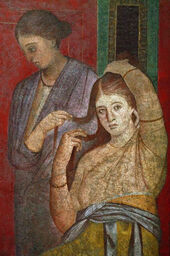
.Roman women, Roman painting circa AUC 830s
Family and Law[]
A daughter kept her own family name for life, not assuming that of her husband (a tradition unchanged in modern Romania). Children usually took the father's name. In the Imperial period, however, children might sometimes make their mother's family name part of theirs, or even adopt it instead.
From the start of the Roman republic, there was a high emphasis placed on a woman's virginity. A woman's sexual life began with the consummation of her marriage in her husband's cubiculum, or private room where slaves did not enter. In Roman houses it was common for men and women to each have their own cubicula, allowing potential for them to engage in sex lives separate from each other.

Roman marble statue of a woman, circa 7th to 10th century AUC
Roman women could own land, write their own wills, and appear in court. An emancipated woman legally became sui iuris, or her own person, and could own property and dispose of it as she saw fit. If a pater familias died intestate, the law required the equal division of his estate amongst his children, regardless of their age and sex. A will that did otherwise, or emancipated any family member without due process of law, could be challenged. From the late Republic onward, a woman who inherited a share equal with her brothers would have been independent of agnatic control.
Roman marriage was, in the Roman ideal, one of mutual loyalty, in which husband and wife shared interests, activities, and property. In the earliest periods of Roman history, Manus Marriage meant that a married woman would be subjugated by her husband, but that custom had died out by the AUC 650s, in favor of Free Marriage which did not grant a husband any rights over his wife or have any changing effect on a woman's status. Free marriage usually involved two citizens, or a citizen and a person who held Latin rights. In a free marriage a bride brought a dowry to the husband: if the marriage ended with no cause of adultery he returned most of it. So total was the law's separation of property that gifts between spouses were not recognized as such; if a couple divorced or even lived apart, the giver could reclaim the gift. Divorce was a legal but relatively informal affair which mainly involved a wife leaving her husband’s house and taking back her dowry. Divorce was socially acceptable if carried out within social norms (mos maiorum). By the time of Cicero and Julius Caesar, divorce was relatively common and "shame-free," the subject of gossip rather than a social disgrace.
Women and Sexuality[]
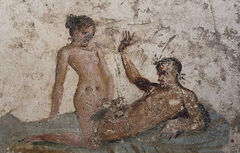
Roman brothel, depiction circa AUC 830
A concubine was defined by Roman law as a woman living in a permanent monogamous relationship with a man not her husband. There was no dishonor in being a concubine or living with a concubine, and a concubine could become a wife. Gifts could be exchanged between the partners in concubinage, in contrast to marriage, which maintained a more defined separation of property.

Goddess Venus, Roman painting AUC 2238
Roman law did not allow any domestic abuse by a husband to his wife, but as with any other crime, laws against domestic abuse can be assumed to fail to prevent it. Cato the Elder said, according to his biographer Plutarch, "that the man who struck his wife or child, laid violent hands on the holiest of holy things. Also that he thought it more praiseworthy to be a good husband than a good senator." A man of status was expected to behave moderately toward his wife and to define himself as a good husband. Wife beating was sufficient grounds for divorce or other legal action against the husband.
Roman wives were expected to bear children, but the women of the aristocracy, accustomed to a degree of independence, showed a growing disinclination to devote themselves to traditional motherhood. Most elite women avoided breast-feeding their infants themselves, and hired wet-nurses. Since a mother's milk was considered best for the baby, aristocratic women might still choose to breast-feed, unless physical reasons prevented it. If a woman chose to forgo nursing her own child she could visit the Columna Lactaria ("Milk Column"), where poor parents could obtain milk for their infants as charity from wet nurses, and those who could afford it could choose to hire a wet nurse. Breastfeeding by elite matrons was idealized as a practice of the virtuous old days. The extent to which Roman women might expect their husbands to participate in the rearing of very young children seems to vary and is hard to determine.

Roman fresco AUC 700-800s
Large families were not the norm among the elite, though they were among the commoners.
Daily Life[]

Roman fresco AUC 800s
Women appear as much engaged in business and as interested in speculations as Roman men. They work their estates, invest their funds, lend and borrow. We find one among Cicero's creditors, and two among his debtors. Although Roman society did not allow women to gain official political power, it did allow them to enter business. Even women of wealth were not supposed to be idle ladies of leisure. Among the aristocracy, women as well as men lent money to their peers to avoid resorting to a moneylender. Women also joined in funding public works, as is frequently documented by inscriptions during the Imperial period. Because women had the right to own property, they might engage in the same business transactions and management practices as any landowner. As with their male counterparts, their management of slaves appears to have varied from relative care to negligence and outright abuse.

Roman bust, Flavian Period, AUC 840s, a good example of a wealthy woman's hairstyle.
Men argued firmly to block women from engaging in the public sphere. The political system in Rome involved men exclusively—from senators to magistrates. Women were even prevented from voting. They were not seen as fit to be part of the political sphere as men believed them to be only suited for "elegance, adornment, and finery."
Women were present at most Roman festivals and cult observances. Some rituals specifically required the presence of women, but their participation might be limited. Women priests played a prominent and crucial role in the official religion of Rome and with later Hellenism. Although the state colleges of male priests were far more numerous.
Wealthy women traveled around the city in a litter carried by slaves. Women gathered in the streets on a daily basis to meet with friends, attend religious rites at temples, or to visit the baths. The wealthiest families had private baths at home, but most people went to bath houses not only to wash but to socialize, as the larger facilities offered a range of services and recreational activities, among which casual sex was not excluded. There is clear evidence of mixed bathing from the late Republic through the Post-Classical Era. Both women of lower-class women bathed with men and women of the highest social classes could be seen naked at the baths. Hadrian prohibited mixed bathing, but the ban did not endure, existing through the Post-Classical Era. Most likely, customs varied not only by time and place, but by facility, so that women could choose to segregate themselves by gender or not. For entertainment women could attend debates at the Forum, the public games (ludi), chariot races, dinner parties, and theatrical performances. Conservatives such as Cato the Elder considered it improper for women to take a more active role in public life; his complaints indicated that indeed some women did voice their opinions in the public sphere. Though the practice was discouraged, Roman generals would sometimes take their wives with them on military campaigns. Wealthy women might tour the empire, often participating or viewing religious ceremonies and sites around the empire.
History of Roman Women in the Modern Age[]
In the arena of gender equality Romania began an early move, compared to most nations of the world, toward giving women a voice in society.
Roman women have long held the right to speak publicly, to divorce, own property, and so forth - these aspects held since at least the First Empire and with increasing liberty after. The move toward full equality in the modern era has its roots in AUC 2407 with the establishment of the Rhea Silvia Society by Màrias Guidu after her travels around Ganonsia and the inspiration she found there. The RSS campaigned for women's suffrage and, by 2410, gained it, as well as a changing of the view of women in society. Even so, Romania continued to lag behind in many respects, as did much of Europe and indeed the world outside of Ganonsia, Azania, and a handful of other nation-states.
It would not be until the 2700s and the shift in society brought on by the World Order War that women in society would gain great gains and changes, with workplaces and ideas opening up for women in Romania for the first time.
Though suffrage and the status of women have been enshrined for some time, there are many in society who argue that Romans have not gone far enough and is still quite sexist, and frequently indicate Ganonsia, Vasconia, and Bakitara as prime examples of areas where Romania is lacking even still.
Women’s rights in Romania are considered broad and the country is often highly rated in this arena. In Romania there is broad acceptance of open public breastfeeding, regarded as a norm, and, as with men, certain areas (parks, beaches, etc) are free to toplessness. The pay gap in Romania is considered largely non-existent and women are open to all occupations and have largely been integrated as such. Maternal care and maternal leave are among the highest in the world (45 weeks with no pay loss), violence against women is low and when it occurs is taken very seriously. Abortion rights are fully in place and divorce as well.
Nevertheless, Romania is regarded by some as suffering from Pedestal Sexism or Ambivalent Sexism. Cultural norms embedded from the past remain in play among Romans, with dyadic power reflecting the notion that men depend on women to fulfill certain goals, such as intimacy and childbearing. Roman men's dependence on women is what fuels benevolently sexist attitudes, leading to idolization and the placing of women on a pedestal. In Romania paternalism reflects views of women as underdeveloped adults or care-taking mothers, providing justification for men to be authoritative and monitor, protect, and make decisions on women's behalf. Gender differentiation promotes the assumption that biological differences between males and females justify the strict adherence to socially prescribed gender roles and, even if officially beyond this, Roman culture has not let go of this notion. The long held views of women as sexual objects for men's pleasure and admiration, and as objects of perfection, romanticizes women as having sexual purity and views romantic intimacy as necessary to complete a man. This is called the Venutian Complex in Romania. The continued obsession with beauty pageants, the fashion industry, the general objectification of women are each examples of this.
In the words of the prominent Roman feminist and mayor of Milan, Tiadora Floris, “Romania continues to suffer from what we call Pedestal Sexism, a nation with the Venutian Complex. The embedded endearment to beauty pageants, fashion models, the lingering tunnel view of women as perfection in motherhood, the continued obsession with long standing ideas of physical perfection and beauty, admiration of women that views us as statues - all of this and more erodes Roman attempts at true gender equality. I can certainly pat my fellow Romans on the back for the leaps made toward equality over the decades, but if one is going to be honest then we have to say that Romania continues to fall short. The pressure on Roman women to be perfect is immense and constant. We are a sexist nation.”
Relationships[]
Amoric relationships in Romania are defined by a committed outlook , making Roman ideas of relationships at odds with much of the rest of Western Europe, often defined by Cambria, where relationships are more casual and revolving, with casual sexual encounters and a lack of long-term emotional connections.
Roman relationships and love can broadly be defined as the opposite of this casual approach. Casual relations like these are looked down on in Romania and deemed largely unacceptable across age ranges among Romans. Relationships tend to form long term in Romania and slowly build via initial meetings. The Roman nightlife reflects this contrast to the predominant style found in Cambria, for example. In Romania youth tend to place higher value on conversation rather than sexual encounter and Romans tend to not go to clubs expecting to leave with someone, rather they focus on meeting new people and conversing, building emotional connections and potentially going on dates until they 'click'.
It is subsequently more common to be in a relationship in Romania than in much of Europe. Not only is dating more common in Romania, but they often last much longer than typical European relationships, which often end in less than one year. The correlation between dating and the slow-paced Roman lifestyle is evidenced by the fact that Romans usually date for 5-6 years before marriage and people don’t begin to marry until around age 35. Additionally, Romans usually live with their parents until marriage.
Though Romania has longer lasting relationships and a higher rate of marriage than other European countries, and many nations around the world, the birth-rate is still falling to lower rates in the country.
About 25% of Roman women do not have children while another 25% only have one child. The Roman government has tried to limit and reverse the trend by offering financial incentives to couples who have children, and by increasing immigration.
Homophile Rights[]
Romans have historically regarded marriage as a male–female union for the purpose of producing children; Roman law throughout the Classical Era and Post-Classical Era did not recognize marriage between males. Sexual relations between same sex couples was, however, not forbidden. The conquest mentality and "cult of virility" shaped same-sex relations. Roman men were free to enjoy sex with other males without a perceived loss of masculinity or social status, if they took the dominant or penetrative role. Acceptable male partners were slaves and former slaves, prostitutes, and entertainers. The relationships of women are less well documented, though there is enough evidence to suggest a similar situation throughout the Classical and certainly the Post-Classical Era. In the late AUC 1200s the Greek Emperor Ioustinianós declared same-sex relations illegal in Greece and they ultimately became punishable by death. It may be trough this lens that we see the official legalization of same-sex relations in Romania via the Roman law enacted by Emperor Vitalius. We subsequently see no actual change in Romania – male prostitution remained legal as before and same-sex relations remained nonpunishable though they carried social stigma if a man took the ‘feminine’ position.
This status remained unchanged until AUC 2729 which witnessed the legalization of same-sex marriage in Romania. The legalization came upon the back of widespread global movements for inclusiveness of homophile members of society. In Romania this was reflected not only in the marriage law but in movements for an abandonment of cultural shaming of the ‘feminine’ position in a relationship. Romania was the third nation to legalize same-sex marriage.
Romania is largely regarded as very tolerant of same-sex couples and transgender citizens, witnessing very little discrimination according to self-reported statistics and watch-dog statistics. The largest homophile-pride parade takes place yearly in Milan.
Charity[]
Romania is ranked among the top charitable nations in the world, routinely ranked first. The greater majority of this charity is sent abroad, to various nations and peoples of the world.
Roman charitable acts have a strong history tied to Hellenism, which became a cornerstone of the religion and a significant aspect. Charity within Romania was prominent until the modern age when the Roman government largely took the role as caretaker of Roman citizens, providing more than adequate means to a quality life for all Romans.
Since this time the charitable drive among Romans has turned abroad and the country sees regular donations and is the home of many charitable organizations aiding needy countries.
The charitable streak is criticized by some, firstly for the poverty remaining among the Sinti in Romania and secondly that Roman charity is ineffectual abroad, often much of it filters off to Roman and other groups and people while the remainder makes little meaningful impact on the lives of the poor abroad.
Bigotry in Romania[]
Bigotry and racism in Romania have gone through episodes of increase and decrease and are, according to experts, on an increase at present.
The peoples of Romania pride themselves on an absence of overt racial enmity and the country, in the broadest scope, is regarded as one of anti-racism, showing acceptance and diversity. Romania remains among the top globally for societal racial tolerance, though this position has taken numerous blows over history and presently and many have pointed out hypocrisies in such as claim.
In 2764, a report by World Rights Watch pointed to growing indications of a rise in xenophobia within the Roman society and Bakitaran Foreign Minister Kahamba Kutesa has publicly expressed concern after the election of Aeliana Berninu as First Consul. In a desire to reduce global and racial antagonism, widespread student movements inside Romania have witnessed a grassroots movement to draw Romania closer to Persia, their historic rival, and have gone through great lengths to combat entrenched cultural racism within Romania.
Examples of historical racism can be seen in the anti-Jewish belief rooted in the Classical Era. Relationships between the Jewish people and the Roman Empire were at times antagonistic and resulted in several rebellions. The emperor Tiberius expelled from Rome Jews who had gone to live there while the destruction of the Temple and sacking of Jerusalem was the culmination of this anti-jewish stance. Ultimately the Emperor Hadrian would change Judaea province's name to Syria Palaestina in an attempt to destroy this regions identity. The Post-Classical Era witnessed a rebirth in anti-Jewish racism following the status of Judea as a chief Persian ally and 'all Jews' as under the Shah's protection. With the re-sparked rivalry between Romania and Persia came a rise in anti-Jewish thought. The Jews of Romania began to be viewed suspiciously, as potential enemies from within. Flare ups of anti-Jewish violence tended to follow the Roman-Persian wars throughout history henceforth. Present day casual racism towards Jews is very similar to Roman casual bigotry towards Persians with stereotypes of both as treacherous and malicious stock villains.
Historically held anti-Persian views have permeated Roman society since the Classical Era. Numerous anti-Persian stereotypes abound in Romania. Romans tend to view Persian as their natural enemy and as their opposite, almost by rote. The Roman film industry has been criticized for its excessive and continuous use of Persians as villains. Persia is stilled viewed broadly in Romania in a negative light, though there have been numerous attempts, particularly among student-movements, at bridging the gap between the two powers. The term facifócu (an ethnic slur targeting Persians that means fire-face) continues to show up during international sporting events, particularly football matches.
Bigotry towards Christianism is fairly widespread and even casual prejudice and jokes about the religion abound. Prejudice towards Christianism has not met the same degree of critique and shaming as racism against the Sinti or Libians or Persians has. Referring to Christians as Galileans is still commonplace in Romania despite complaints by the Christian community and it is not uncommon to find mockery of the faith. The Caergrawnt Circus, a popular Cambrian comedy group, have made mockery of Christianism and Judaism a popular theme, especially in the movie Wella the Prophet, which found immense popularity in Romania. The iconoclasm of Christianity is seen as a stark contrast to the icon and statue heavy Hellenism and Christians are mocked for being 'afraid of nudity'. Likewise the running stereotype of intolerant Christian nations is a common theme, ironically. Armenians are further believed to be untrustworthy and backstabbing with Romans blaming Armenia for repeated betrayals throughout history.
The Sinti have perhaps suffered the most from racial prejudice within Romania. The historical enslavement of the Sinti spurred a lasting handicap on the Sinti community that has lasted to the present day. In Post-Classical Romania slavery remained widespread and almost all slaves originated in eastern Europe, northern Libia, Hibernia, or western Asia before being completely supplanted by the mass enslavement of the Sinti, henceforth the exclusive source of chattel. AUC 2619 witnessed the full emancipation of the Sinti but the broad anti-Sinti sentiment never faded. Discrimination abounds and many Sinti faced violence during the chaos of the WOW. A report issued by the Society of Conscience in 2764 claims that "systematic discrimination is taking place against the Sinti in Romania. The organization has documented the failures of the government to live up to their obligations." Roman Professor Dionìsi Nigellu has written articles stating that Sinti are culturally inclined toward theft and use their minority status to 'blackmail' the majority, an example of widely held bigoted beliefs in Romania.
Historically Sub-Saharan Libians (particularly West Libians via the Asante markets) were broadly purchased as rowing slaves aboard Roman ships in the Post-Classical Era and the ethnic slur, remagena (a union of the word 'rematòre', rower, and the word 'melangena', eggplant), has lingered to the present day. Some racist incidents have been noted during football and gymnastic sporting events targeting Sub-Saharan Libians. Libian migrant communities have noted some discrimination against them in Romania, though the incidents are evidently uncommon or at least not widespread. This is attributed to a less hostile view toward Libians overall by Romans, although the smaller numbers by the Society of Conscience are attributed to there simply being fewer Libians in Romania and they do note the increase in racial prejudice that is accompanying climate refugees from Libia which is witnessing a substantial increase in their numbers coming to Romania. A survey among Libian migrants suggests a fairly open society. Libian and Libian-Roman's have a broadly satisfactory experience living in Romania, according to reports, and the lot of Libian and Libian-ancestral people in Romania remains fairly positive.
The Persian author Afiveh Felfeli is quoted as saying, "The Romans hide from their own misdeeds by shielding themselves with the errors of others. They hold up the evil deeds of the Persians that we might not see the evil done by Romans to their fellow men. The self-righteousness that Romania declares for bringing to justice those responsible for the plight of the Armenians is belittled by the suffering of Sinti, Jew, Meshican, Antillian, Abyssinian, or Osajian at the hands of Romans.
National Image[]
The internal and external evaluation of Romania's national image is significantly and repeatedly highly ranked. Globally assessed, the country's reputation in terms of culture, politics, exports, its people and its attractiveness to tourists, immigrants and investments, has remained among the highest in the world. Romania has been named the world's third most valued nation among 50 countries in 2763, behind Cambria and Sina. With an expenditure of £70 billion on international travel in 2761, Romans spent more money on travel than any other country. Romania garners global popularity in sports, beauty pageants, cinema, science, and education – regarded as a leader in these categories as well as others.
The global status of Romania has fallen in recent years due to the ongoing wars in Hesperia and Libia and the growing appearance of the state going rogue on the global scene.
Persia, among other nations, is of the opinion that Romania is a global autocrat, cultural imperialist and bully, with Romania having held a longtime position of hegemonic power, with Sina, Roman weight and culture have long played important factors in global events.
Social Class[]
Nepotism, Aristocracy, and the Patricians[]

Dominu Carolu Maximu, the head of the House of Maximu, among the oldest Patrician families in Romania
The incessant presence of patrician nepotism in Romania is rooted in the furthest reaches of Roman history and has accompanied the country through all manners of government that it has held. Though the more overt form of aristocracy practiced in the Kingdom, First Republic, First Empire, Second Republic, and Second Empire has vanished completely due to the Roman Revolution, there nevertheless remains a more subdued variant in modern Romania that appears almost "too Roman to abandon completely".
The Patricianship is a legally protected and recognized hereditary title that is empty and void of any earthly power. The only exception the title and those holding it has in contrast to the majority of Roman citizens is it is legal only for Patricians to have their official titles and only patrician families may have familial crests and only they may display their given crest.
The members of a patrician family holds titles (Dominu, Domina, usually abbreviated Dom.), crests (the only families in Romania), all essentially retaining the trappings of the Imperial era Equestres and Patricians without the domination, politically, that they had. The Patricianship therefore remains in a twilight area - legal, recognized, protected, yet not legally bound to power and, in fact, constitutionally barred from it. This existence came about as what was dubbed the 'Great Hereditary Compromise' in the wake of the Revolution. To prevent dissent from within and to help ease governmental transition, patrician families were allowed to retain these privelages. Many Revolutionaries termed it the "Great Hereditary Betrayel".

Domina Claudia Raineres, Miss Rome, is a member of the House of Raineres and winner of the 2767 Miss Romania competition.
In recent examinations it has been found that even today many of those in government hail from senatorial and/or patrician families, the wealthiest (even despite the prominent wealth-tax) in Romania hail from patrician families, and many of those in powerful positions hail from patrician families. These are all families with patrician roots dating back centuries, many to the First Republic and yet many from later periods, particularly the Second Republic. Many patrician families (known as Houses, or Casas, with preference for 'casa' over 'dominu' in this instance) retain expensive estates and castles throughout Romania and have benefited from the Roman governments adherence to family-farms and other family-run business, therefore assuring that many of these already extensive land-owning families are well placed in the financial Roman world, even within such an equalitarian society.
Roman popular attitudes toward the patricians remains confusing, with a mixture of admiration coupled with antagonism. Nepotism remains rooted in Roman culture, partly due to the firmness with which family life is held. Accusation of favoritism aren't uncommon, with patrician families supporting other patrician families. The crowning of Claudia Raineres in 2767, the sixth patrician to win the Miss Romania competition, was not without claims of favoritism. Many patrician families have histories of senatorial service and have made it a habit over the generations to continue that occupation, thus creating the rift wherein numerous individuals running for office are patricians, thereby resulting in many plebs continuing to vote in patricians as the cycle goes on. Roman people often admire patrician families and, by extension, many celebrities and politicians are patricians and admired regardless, thus making them de-facto 'admired patricians'. Popular magazines, tabloids, and so forth, cover the lives and images of patricians and many Romans love the gossip and details of these families and their celebrities. Yet the contrast with the supposed values of the Revolution and modern Romania are in stark contrast with Patriciandom. Just as the law forbades Patricians and safeguards them at the same time, the Roman popular opinion is a contrast that at once cancels itself out.
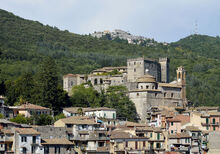
The House of Maximu's caslte in Arsula, southern Italia Diocese. Patrician families retain estates, many of them multiple estates.
One aspect of the retention of patricianship within Romania was the outlawing of new families. Only those existing pre-Revolution, as Patrician houses, may hold the status and benefits. This has led to many modern Romans who have gained wealth to become known as Little Patricians, as they have gained the status, wealth, and popularity, but not the benefit of titles nor family crest.

Roman actress Julia Bibitaqua is among the patrician class, hailing from the Bibitaqua family which gained prominence in the 18th century AUC
The social mobility and broad income equality in Romania has, many researchers believe, led to the current status wherein Patricians are not held is a utter contempt as they had been, pre-Revolution. Snobbery and elitism garners its own sort of disdain and annoyance by the population at large, but the Patrician class do not hold a horded wealth in a realm of great inequality as was found before, which has, arguably, been a key factor is allowing the status of Patrician and its benefits to remain, as few in Romania suffer and thus there is no popular movement against.
Patrician dominance can be found in myriad avenues of Roman culture and life: Claudia Ranieres, the winner of Miss Rome and then the winner of the Miss Romania 2767 competition, is a member of the House of Raineres patrician family, who trace their noble origins to a 17th century Equestres (Knights) who rose up in status and established his families patrician status to this day. This lineage includes not only Claudia but also Senator Valeriu Raineres, Admiral Fulviu Raineres, and the actress Coriña Raineres - representing fashion, government, military, and entertainment, not an uncommon thing for a patrician family.
The well known Bibitaqua family has name presence with the popular actress Julia Bibitaqua. The Bibitaqua's came to prominence in the early 1700s and became Vicars of Italia and also provided an array of High Priests over the course of the Post-Classical Era.
The House of Berninu, which includes sitting Consul Aeliana Berninu and her father, ex-Senator Albertu Berninu, are members of the patrician class with a lengthy history of Senators in their history.
A well known patrician family, the House of Maximu, is one of the oldest in Romania; the line descends from the ancient Gens Fabia of the First Republic, from Quintus Fabius Maximus Verrucosus (c. 479 – 551 AUC), called Cunctator ("the Delayer"). The Maximu family has provided two Pontifices as well as the famous mountaineer Valeriu Maximu (the first to scale Mount Sagarmatha, the highest peak in the world. Arrogantly the Romans called said mountain Mount Maximus for decades before relenting and using the official Nepali name Sagarmatha).
Roman Patrician Family Crests[]
Augustuship[]

Serenissima Cesarissa Arisia Intica Raveni Borromeu is the current heir to the Borromeu house and therefore carries the title Serenissima Cesarissa.
The Roman Augustuship was abolished at the conclusion of the Roman Revolution as well. However, the position currently holds legal status in the Roman Constitution, yet it is not a figurehead position and holds no power whatsoever. The Augustuship is, in its simplest definition, simply a Patricianship with unique titles, operating the same as the hereditary and legally protected Patrician status, the Augustuship essentially has no difference save for its name and title.
Previously the full imperial title was Serenissimu/Augustu/Imperatore/trice followed by the full name of the emperor/empress which, especially for the nobility, was usually lengthy in itself and with some dignity attached to the end of it. This title-style emerged via reforms by Tribunus Urseolus in the mid 1600s. He was the first to style himself Serenissimu Imperatore Augustu. The switching place of Imperatore and Augustu would result from the development of Roman over Latin, though the word placement translated the same - Most Serene August Emperor.
The heir to the throne, from Tribunus' time on, was titled Caesare/Caesarissa which in Roman became Cesare/Cesarissa.

The Borromeu Dynasty crest
At present the Borromeu family retains the dignity of the title Serenissimu/a Augustu/a held by the current hereditary head of the house, while the heir holds the title Serenissimu/a Cesare (or Cesarissa). The title Imperator/Imperatrix was banned after the Revolution.
They are typically addressed as Serenissimu/a, depending on the gender of the title holder. The titles are nominal and hold no legal authority, power, only protection in the Constitution (which has protections against the title as well). Myriad royal estates across Romania are also retained by the Borromeu family, with the familial headquarters on the Borromean Islands located in Lake Verbanu, and the island Borromia among Romania's Hesperian territories, as well as the Imperial houses in Ravenna, but they are otherwise void of any forms of power.
The family is not barred from running for political office however and though none have found success a number have made attempts. The family is additionally involved in a variety of businesses including the fashion company Verbanu Group, directorship of the popular weekly news magazine Herculiana, partial directorship of the Miss Romania organization, and involvement in the art dealership business under the prominent company Lucania. The Borromeu are subsequently one of the wealthiest families in Romania, in so far as they are able to be within the confines of the egalitarian economic system.
The royal family also provide ample opportunity for tabloid and pop-culture fodder as prominent celebrities at home in Romania and, especially, abroad, with their involvement in the celebrity world, fashion world, and global aristocratic sphere. They are popularly known globally as the Last Caesars and the Eternal Emperors.
Patricolos[]

Valentina Lauduvinos, a wealthy Roman actress who can be considered a Patricola
The Patricolu, Roman for Little Patrician, are akin to being modern day novus homo ("new man") and they are sometimes called this, using the Old Roman (Latin, or Classical Latin) word or the modern version, novu hòmine.
Typically this refers to celebrities such as actors and musicians or to any Roman who has accumulated wealth, prestige, and fame. Often jet setters, faces of global brands, Romans who have managed to accumulate wealth despite the prominent Roman wealth tax - Patricolos are upper class Romans, patricians, by virtue of money, power, and fame as well as political and cultural influence.

Ofelia Paganos is representative of the Patricolos, many of whom influence broader style, fashion, and ideas in Roman society - a sort of top down culture acquisition.
The love-hate view of the Patricians by Romans is seen in no better way than how they perceive the Patricolos. A mixture of envy and spite, most Romans are very familiar with their fellow Romans in this class and are often fans of them in some form or another, be they actors or musicians. Many Romans additionally support many celebrities and popularly following their doings, with many aspiring to such lofty positions. Yet, the dichotomy reveals a disdain for privileged positions within Roman society and there is regular debate and derision towards the Patricolos and the remaining hereditary Patricians and what is seen as the negative influence they have on seeing true and full Equalitarian ideas and politics in Romania.
This disdainful view held of such wealth accumulation and the societal detachment that accompanies it is a constant topic among Roman thinkers, with the seeming inability for Roman culture to shake hierarchy being a prominent topic, viewed in everything from Hellenism to Television.
Seen as a class apart, aloof, and counter to Equalitarianism, Little Patricians are a source of contention and admiration in modern Roman society.
Geography[]
Mainland, or European, Romania stretches from the Iberian peninsula in the west to the eastern Alps in the east. Significant features include the Alpes (Alps) centrally, with the notable Montes Pallidos (Dolomites) the Selva Negru (Black Forest) in the north, the Montes Appeñines, or Appeñinu (Apennines) in the south, in the west the Montes Dragos (Guadarrama), Montes de Stella (Serra da Estrela) Montes Cantabricu (Cantabrians), and the Montes Pyrenes (Pyrenees). Significant rivers include the Danuviu (Danube), the Rhenu (Rhine), the Liger (Loire), the Tigus (Tagus), and the Rhodanu (Rhone).

Roman territories
Western Romania has an Oceanic climate, southern Romania has a Mediterranean climate, and central-eastern Romania is classified as having a Continental climate. Four seasons occur in most of Romania away from the Mediterranean. The coastal lowlands near and on the Mediterranean Sea, have more of a wet and dry season pattern, with winter the season of most rainfall, and summers a time of few rainy days.
Romania includes 11 overseas territories. Most are insular climates, including equatorial climates, while a few warm-arid, bordering on desert.
Italia[]
Italia Diocese consists mostly of the Italic Peninsula (or the Italic Peninsula, Apennine Peninsula). It is a very mountainous region, with the Apennines running along the length of it. It shares an Alpine border with Raetia, splitting ranges such as the Dolomites between them.
The Po, Italia's longest river, flows from the Alps and crosses the Padan plain on its way to the Adriatic Sea. The Po Valley is the largest plain in Italia and it represents over 70% of the total plain area in the Diocese.
Four different seas surround the Italian Peninsula in the Mediterranean Sea from three sides: the Adriatic Sea in the east, the Ionian Sea in the south, and the Ligurian Sea and the Tyrrhenian Sea in the west.
Because of the great longitudinal extension of the peninsula and the mostly mountainous internal conformation, the climate of Italia is highly diverse. In most of the inland northern and central regions, the climate ranges from humid subtropical to humid continental and oceanic. In particular, the climate of the Po valley geographical region is mostly continental, with harsh winters and hot summers. The coastal areas of Liguria, Tuscia and most of the South generally fit the Mediterranean climate stereotype. Conditions on peninsular coastal areas can be very different from the interior's higher ground and valleys, particularly during the winter months when the higher altitudes tend to be cold, wet, and often snowy. The coastal regions have mild winters and warm and generally dry summers, although lowland valleys can be quite hot in summer.

Picenu is a region in central Italia
Over 35% of the Italia is mountainous. The Apennines form the peninsula's backbone, and the Alps form most of its natural northern boundary.
Italia is among the most popular spots among Romans, steeped in Roman history as the birthplace of Rome under Romulus and the destination of the sire of the Roman nation, Aeneas. The warm weather also makes Italia a popular vacation spot for Romans on holiday and, when not exploring other countries or Romania's Overseas Territories, Romans tend to find themselves visiting and enjoying Italia, the "Pillar of Romania".
Raetia[]
Raetia is the most forested Diocese of Romania and consists of stretches of dense pine forest. The famous Selva Negru is found in the north-central part of the Diocese. The southern border of the Diocese, along Italia, consists of the Alps, including the famous Pallidos Mountain range.
Famous Alpine valleys include the Clarufont while the world renowned Alpine peak Servinu is also located in Raetia.
Many large glacial lakes can be found in Raetia, including Lacu Brigantia, with the picturesque town Brigantiu on its shores, and Lacu Lausoniu, one of the largest lakes in Europe, with the northern shore of the lake in Raetia and the southern shore in Gallia Diocese.
The Rhine river runs down the center of Raetia and has long been a vitally important part of the area.
The climate is generally temperate, but can vary greatly between the localities. Winters range from cold in the southern Alps to mild and are generally overcast with limited precipitation, while summers can vary from hot and dry to cool and rainy.
Raetia's Provinces are Sequania, Belgica et Germania (an amalgamation of the two former Provinces Belgica and Germania), Vindelica, and Noricu.
Raetia's Regions are Marciana, Hercinia, Svebia, Helvetia, Veñonia, and Juria
Gallia[]
Gallia is a very diverse Diocese geographically. The Pyrene Mountains seperate distinct areas, while the Alps further divide portions of Gallia, north-south, with the Maritime Alps in Gallia.
The Rhodanu (Rhone) River is of vital importance to the area.
Southeast Gallia's land is a type of low, soft-leaved scrubland or chaparral found on limestone soils around the Mediterranean Basin, generally near the seacoast, where the climate is moderate, but where there are annual summer drought conditions. Juniper and stunted oaks are the typical trees; aromatic lime-tolerant shrubs such as lavender, sage, rosemary, wild thyme and Artemisia are common garrigue plants. The open landscape is punctuated by dense thickets of Kermes oak. Most of the area has a Mediterranean climate, characterised by hot, dry summers, mild winters, little snow, and abundant sunshine.
Central Gallia is known for its mountain ranges and dormant volcanoes as well as forests of oak and landscape covered in hills, mountainous and dotted with pastures.
Taifalia, that is northeast Gallia, is known for its coastal plains and Atlantic climate.
Marca[]
Insular[]
Overseas Territories[]
Romania's overseas territories began with the Roman exploration of the Atlantic in 2156. The remnant of overseas land that Romania holds is what remains from the end of the Great Eurasian War, while Romania also has held much more extensive territory prior to that as well.
The colonization of Romania's overseas lands has resulted in a fairly broad movement from all corners of Romania into these territories over centuries, resulting in a uniformity of language that does not deviate from standard Roman. Likewise the territories have seen a melding of Roman culture from across Romania, again leading to a broadly generic Roman culture, language, and populace. Some migration from neighboring European countries, especially those Hellene states, has been witnessed, especially in Concordia, Soleterra, and Boriquen - with particular numbers from Morea and Hibernia. The traces of indigenous culture in Romania's overseas territories is gone, owing to the fact that those lands the Romans settled were not disease immune and the populations were thus completely decimated - this is likely a partial reason these areas were able to remain Roman, as like-colonized territories that had numbers and disease immunity were never able to remain under Roman control or colonization. An exception is in Cape of Storms Territory, where in the city Spesbona around 10% of the population are native Libian.
Another exception comes with Isula de Vènere, which is uninhabited.
Fortunate Islands (Isule Fortunate)[]
Diabolic Islands (Isula de Diàvulu)[]
Boriken (Boriquén)[]
Soleterra[]
Concordia[]
Beautiful Island (Isula de Vènere)[]
Frigid Island (Isula de Frigidu)[]
Hellenia (Isula de Hellenia)[]
Cape of Storms (Capu de Tempestas)[]
Apolonia[]
Politics[]
Administrative Divisions[]
Romania is subdivided into five Dioceses and, below that, 22 Provinces (Provincias) and 16 Municipalities (Municipias), followed by 45 Regions (Regios). Below this is the Community (Communia), the base layer of Roman government which is made up of all citizens and varies in size by given Community.
Romania's 10 Overseas Territories (Territorias) largely resemble Provinces, they have nearly the same political status, although special constitutional provisions allow them greater autonomy and they are excluded from certain domestic statistics, such as the unemployment rate. The only exception is Isula de Vènere, which is uninhabited.
The Provinces and Municipalities act largely the same. The Municipalities (Municipias) are essentially Communia that have grown so large that they require governing on the level of a Province - essentially City States. Thus the Municipalities have Governors just like the Provinces and are also broken down internally into Regions and Districts just as provinces are.
Dioceses[]
Romania is considered a federal republic. Though the central government has the ultimate authority, the internal working of Romania is moderately devolved and degrees of autonomy rests with the five Dioceses.
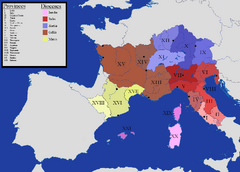
Romania's current administrative divisions
It is often argued that Romania's notion of being a federal state, where the central government has overriding powers, is thus not truly a federal state, but a quasi Unitary State and quasi Federal.
Each Diocese has its own constitution, and is somewhat autonomous in regard to its internal organisation, though the Diocese possess no powers in relation to foreign policy and so enjoy no independent status, rather only with certain internal functions and laws.
Federalism became entrenched in Roman Law after the Roman Revolution, as a means of devolving the centralized Imperial authority and, thus, making more assurances against such a possible consolidation of power ever again. Federalism is one of the entrenched constitutional principles of Romania as a result.
According to the Roman constitution, some topics, such as foreign affairs and defense, are the exclusive responsibility of the Republic (i.e., the federal level), while others fall under the shared authority of the dioceses and the republic; the dioceses retain residual or exclusive legislative authority for other areas, including "culture", which in Romania includes not only topics such as the financial promotion of arts and sciences, but also most forms of education and job training. In matters that affect the dioceses directly, they defend their interests at the federal level through the Federal Council or simply the Federate (Federatu Conciliu).
The Dioceses are governed by a cabinet led by a Vicar (Diocese Governor), with his or her council consisting of those chosen by the Vicar, governing the Diocese together with a unicameral legislative body known as the Diocese Senate, which consists of Senators elected Provincially via popular vote.
The Provincial Governors, popularly elected, are part of the Vicar's Diocese government as well as being the chief executive of their given Province or Municipality, where they work in conjunction with the various Communal Councils that make up said Province.
The dioceses are mini-republics and the relationship between their legislative and executive branches mirrors that of the federal system, save their being only one Vicar (while federally there are two Consuls). The legislatures are popularly elected for five years.
| Diocese | Flag | Capital | Vicar |
|---|---|---|---|
| Italia | Florentia | Valeriu Ulpianos | |
| Gallia | Arverna | Felix Balventiscu | |
| Raetia | Cuira | Silvia Liviscu | |
| Marca | Toletu | Attio Potitiu | |
| Insular | Carales | Helvia Pirra |
Government of Romania[]
The Government of the Roman Republic was established in AUC 2569 after the deposition of the last Emperor.
The Roman government is divided in three – executive, legislative, and judicial. It is composed of six elements: Assembly, Tribunal, Senate, Federate, Council, and Consulate. The executive branch of government consists of the Consulate and the Council. The legislative branch of government consists of the Senate and Federate. The judicial branch consists of the Tribunal. Lastly is the population at large, with all legal citizens of the Roman Republic considered the Assembly.
Governing and Voting Process in Romania
The Assembly (all legal Roman citizens) elect Communal Councils in each Community, no matter how small or large said Community is, from town to city. The Assembly acts in conjunction with this elected Communal Council on all matters relating to that Community.
The Assembly elects Provincial/Municipal Governors, Diocese Vicars (who elect their own Diocese Council, who are in turn subject to recall by the Assembly), and the Diocese Senate. The Diocese Senate is elected from candidates within each Province who then make up the Diocese Senate that that Province belongs to.
The Assembly further elects the national Senate via popular votes in each of the 45 Regions within the Provinces. Each Region is broken down into districts which vary by number of Senators, ultimately with there being 435 Senate seats wrought from the 45 Regions. The Assembly also elects one of the two Consuls that sit in the executive branch.

Breakdown of Roman Government
Furthermore the Assembly have voting rights on all issues presented in Romania by the Executive and Legislative branches and are able to present items to vote on nationally as well.
Romania is a country with instruments of direct democracy (at all levels from communal to national). Citizens have more power than in a representative democracy. On any political level citizens can propose changes to the constitution (popular initiative), or ask for an optional referendum to be held on any law voted by the federal diocese senate and/or municipal legislative body.
Roman citizens vote regularly on any kind of issue on every political level, such as financial approvals of a school house or the building of a new street, or the change of the policy regarding immigration, or on constitutional changes, or on the foreign policy of Romania, four times a year.
In Romania, simple majorities are sufficient at the municipal and provincial level, but at the federal level double majorities are required on constitutional issues.
Executive Branch[]
The executive branch has a makeup as follows:
The Consulate consists of the Consuls, the two heads of state and government of the Roman Republic. One consul is elected via popular vote by what is termed the Assembly, constituting all eligible voters in Romania. The other consul is elected by the Senate from among their own members. Both consuls serve a three-year term. The Senate can dismiss either Consul at any moment via an impeachment vote.
Both consuls are considered equal in power and a balance to one another. Reality suggests that the Popular Consul wields a measure of more power and holds considerable sway over the nation.
The Assembly-elected (popular vote) consul (Popular Consul) is the principal chief diplomat for the republic and in charge of foreign affairs, assigns ambassadors (they must be approved by the Council and co-consul), traditionally acts as the commander-in-chief of the Roman military – a role that is not constitutional only traditional, may grant pardons, has a suspensive veto - when presented with a law, they can request another reading and secondary vote of it by the Senate (post-popular vote), but only once per law. They have the unique ability to flout the Council and Co-Consul by proposing referendum laws as well, though these must be approved by the Senate if voted in the affirmative by the populace (regular procedure has the laws crafted collectively by both Consuls and the Council and decided on by the Senate and the people, popular referendums created by the people that go to the Senate - basically a reverse of the previous method, or Senatorially drafted laws approvable by the Senate and the people). The Popular Consul also is the only Consul needed to finalize Senatorially drafted laws (after being voted on by the Senate and the people). What’s more, the will of the Popular Consul holds immense sway. Going against their positions is perceived as negating the will of the people, which the Senate and Council and Co-Consul aren’t fond of doing.
The Senate-elected consul appoints Tribunal members (though they must be approved by the Council and co-consul), are in charge of an array of budget issues, and submits to the Senate the annual and pluriannual Budget Law, as well as the relevant financial statements of the State and of State Corporations, accompanied by the necessary reports (the Senate is required to approve). This Consul acts almost more like an executive safe guard by the Senate.
Each consul rotates as head of the Senate each month, residing over meetings and acting as the tie breaker in votes. The consuls can draft laws, though they must be passed by the Council, then the Senate, and are eligible for veto by the public via referendum. Consuls may be elected twice in their life but may not exceed two terms.

Typical terminology to differentiate the two consuls (as legally and officially both are simply called Consul) are for the consul elected by popular vote: Consul of the Plebs, popular-consul, people's consul, assemblies consul, assembly-elected consul, or popular-elected consul. For the consul elected by the Senate: Consul of the Senate, senatorial-consul, senate's consul, Number Ten (a reference to the idea that this consul acts as the tenth member of the Council), government's consul (usually derisively).
The Council consists of nine members elected from the Senate by the Senate. They act the secondary executive, on par with the Consulate. Generally the elected group lasts four years as the Council, but it can be forced to resign by a senatorial vote of no confidence. Each elected Councilor is chosen for a post:
Councilor of State for Internal Affairs and Civil Defense
Councilor of State for Finance, Budget and Programming
Councilor of State for Education, Culture, University and Justice
Councilor of State for Territory, Environment and Agriculture
Councilor of State for Health and Social Security
Councilor of State for Trade and Relations with the Town Council
Councilor of State for Communication, Transport, Tourism, and Sport
Councilor of State for Industry and Crafts
Councilor of State for Labour and Cooperation
Collectively the Consulate and the Council decide on international policies for Romania, as well as international treaties and agreements concerning general international policies and matters relevant for the State’s security.
They determine the general administrative policies by defining the relevant objectives and general programmes and by issuing the necessary general directives of the Public Administration. They are entrusted with the legislative initiative by drafting the laws to be submitted to the Senate for their approval; decide on any other matter concerning the implementation of the Government programme, unless otherwise provided for in law provisions. They adopt delegated decrees voted on by the Assembly (referendum laws initiated by the population and voted for); In case of need and urgency, they adopt decrees having force of law and subject to ratification by Senate within three months, under penalty of nullity; Controls expenditure plans, as well as the single interventions, with a view to verifying their compliance with the approved budget and with the directives issued; Proposes administrative provisions falling within the competence of the Senate; and Adopts regulations concerning the forms and implementation modalities of laws, as well as the organisation and functioning of public offices in conformity with law provisions.

Seal of the Roman Senate, the legislative branch of Romania's government
Legislative Branch[]
The Senate is the legislative branch of the Roman government.
Elected via popular vote every five years via the Assembly, senators are elected within each Region (which are within each Province) and each Region is broken down into voting Districts. Senators thus are to represent each Region (and specifically a specific are of each Region) and can be recalled at any time via popular vote by that Region/District's inhabitants.
Guarantees for female candidates exist in the Roman Senate. The Senate approves or vetoes a number of decisions by the executive branch, appoint the Advising Commissions, and the Government Unions. The Senate also has the power to ratify treaties with other countries, co-acting and being the final arbiter for the Assembly-elected consul. The Senate is divided into six different Advising Commissions consisting of senators who examine, propose, and discuss the implementation of new laws that are on their way to being presented on the floor of the Senate.
Though the Consulate may draft laws, these must go through their co-consul, the Council, and the Senate. The Senate, on the other hand, is able to draft laws which only need approval from the Senate itself and the Popular Vote Consul (any law from any source may additionally be vetoed by a popular vote via referendum as every law is presented to the people).

Roman Senate in 2773
Through referendums, citizens may challenge any law passed by senate or consulate and through initiatives, introduce amendments to the republic’s constitution, thus making Romania a direct democracy.
Federal Council[]
The Federal Council, or the Federate, is a legislative body that represents the five Dioceses (federated states) of Romania at the federal level. It is composed of fourteen members, two from each Dioceses and two representing the western sphere of Roman overseas territories and two from the eastern sphere.
The Federate participates in legislation, alongside the Roman Senate, and are the directly elected representation of the people of each Dioceses or the broader Dioceses' interests on the national level.
Each dioceses, regardless of its population size, is equally represented by two federates who serve terms of six years, gaining their seat via popular elections held in each Dioceses. These elections often run alongside elections held for local Diocese based government.
The legislative authority of the Federate is subordinate to that of the Roman Senate, but it nonetheless plays a vital legislative role. The Federate must approve all legislation affecting policy areas for which the Basic Roman Law grants the Dioceses concurrent powers and for which the Dioceses must administer federal regulations.
This approval requires a majority of actively used "yes" votes, so that a diocese coalition with a divided opinion on a bill votes—by its abstention—effectively against the bill. Only 10 percent of all federal laws, namely, those directly affecting the Dioceses, require Federate approval, thus making the Federate one of the smallest legislative bodies in the Republican Government. Even so, the Federate has the ability to drastically alter national course and law. The federal decriminalization law for hard drugs is an example of a legislative act that required the Federate to first give the law approval before it could even move onto the Senate and federal legislative body.
Judicial Branch[]
The Council of the Tribunal serves as the supreme court of the republic. The Senate-elected consul elects the Tribunal (with approval by the co-consul and the Council, with additional potential for Senatorial denial via vote), whose members remain in office until the age of 70 or via removal on the address of the Senate. The Tribunal consists of twelve members, one of which is the Supreme Tribune, the highest ranking and chief judge.
The Assemblies[]
The Assembly acts as a sort of fourth branch of the government. Each Roman is a member of three organizations, the General Assembly, the Communal Assembly, and the Labor Council. The General Assembly is the nation-wide body of voters, all eligible Romans. The General Assembly votes on nationwide issues and engages with the Senate and Consulate. The Communal Assembly acts the same but for local level votes and issues and votes in local governors, etc. They also vote on delegates to the Senate who are to enact the policies of the State on behalf of the Communal Assemblies. The Senators thus sent can be recalled if it is deemed they are not representing the Communia. The Communal Assembly is also the collective owners of localized means of production - the collective owners of communal land. The Labor Council is the workplace democratic body, made up of all workers at a given workplace, a co-op that is semi-autonomous from the Municipal Assembly (which the Labor Council members are also part of). They carry out the administration of the enterprise and the internal workings of said enterprise on a collective and democratic manner, voting on their own work-place Council.
Current Issues[]

Consul Aeliana Berninu
The principal contemporary issues facing Romania today includes the continued financial and life drain of Romania's ongoing war in Hesperia, a wave of anti-Sinti rhetoric sparked by the New Latin League Faction, anti-immigrant stances across the country in light of climate and war refugees from Hesperia and Libia, the continued desire for Romania to see Persian global power hemmed in, with concerns about Persian activity abroad, trade-agreements with Sina and the effect that Sinaean productivity has on domestic productivity.

Consul Cassandra Bergamòne

Youth protest movement in Romania, rallied against rising xenophobia and wars abroad.
Contemporary issues at hand in Romania include administrative problems related to Romania's status as a close financial and trading partner within the European community, the diminishing of Romania's global standing and the reality of not being a hegemonic-power anymore, economic competition with long-time friend Sina as well as loss of global dual-powership to Sina alone or, according to some, to Cambria and Sina, the two ongoing wars (in Hesperia and in Libia), immigration and climate change, racism against the Sinti and immigrants, the power struggle between Consul and Council, calls for increased democracy or warnings against waning democracy within Romania, and attempts to increase the transparency and efficiency of the Council.
Anti-Sinti and counter Sinti-Rights protests have occurred with frequency across Romania over the past decade or under. Romania has come under international scrutiny for its treatment of Sinti and this has proven to be an embarrassing aspect of Roman culture for many within Romania. Various methods and proposals have been propped up as solutions though no solid conclusion has been reached and increasingly anti-Sinti demonstrations have been popping up in a reactionary fashion.

Protest against mistreatment and rising racism by Sinti community in Romania, 2772
At present the principal issue of the war in Abyssinia and the war in Osajia also impedes Roman progression internally and internationally. The Romans are wary to leave a vacuum in either country and also fear losing face if Romania leaves and declares defeat. The international community, though at first roughly split on support and opposition, have largely fallen into the opposition camp and Romania finds little support in continuing the wars. Sina remains one of the few continued supporters for Romania but even this is waning, while Cambria, an early supporter, has withdrawn from the conflicts as of 2771 and is pressuring Romania to do so as well.
Climate change continues to be a broadly concerning issue in Romania and finds little to no opposition in the country. The main issues arise with antagonism towards the idea from oil dominant countries and this is proving to be a major obstacle for Roman-Persian relations.
The global homophile rights movement also impedes Roman relations with some nations, notably Armenia and Arabia, among others, as Roman's campaign for homophile rights abroad and critique those foreign nations that fail in this arena, pushing for sanctions against Armenia and others.
Political Factions of Romania[]
Romania is largely dominated by eight political factions. These are the Spartacus Society Faction, Hellene Democratic Faction, Populares Faction, New Latin League Faction, Optimates Faction, United Democratic Faction, Autonomist Faction, and the Platonic Faction.

Former Consul Mogerines has remained an outspoken critic of the current Consulship
Romania, like most of the world, follows a general populist-paternalist and rationalist-traditionalist also known as the open-closed political division. Following a fairly typical dichotomy found around the world, closed factions usually hold conventionally conservative or traditionalist views on social issues; Open factions often hold rationalist or progressive opinions on many issues.
The Main Factions[]
Though the above eight factions are the dominant forces in Roman politics, there tends to be waves of four major factions in Romania at a time.
The Roman political Factions all adhere to and support equalitarianism, often with variations that they think best, even those that oppose aspects of equalitarianism (such as the Platonic Faction).
Roman political divisions tend to be paternalist versus populist as well as open versus closed – or rationalist versus traditionalist.
The four main factions in Romania at present are the Spartacus Society Faction (populist and rationalist, radical-open), New Latin League (populist and traditionalist, radical-closed), the Hellene Democratic Faction (paternalist and traditionalist), and the Populares Faction (paternalist and rationalist).
The biggest clash between the two main traditionalist, or closed, factions (the NLL and the HDF) include issues over Free Commerce, the Sino-Roman Free Commerce Agreement, the status and support of the patricians, the power of the consul against that of the council.
The biggest clash between the two main rationalist, or open, factions (SSF and the PF) include issues over Free Commerce, involvement in international organizations, issues over increasing democracy within Romania, the need for stronger support of the Sinti and minorities, and the Sino-Roman trade agreement, among other things.
In general the paternalist factions mentioned above tend to believe that the status-quo should be as maintained as possible, the less ripples the better, while the populists hold the opposite view.
| Major Factions | Political ideology | |||
|---|---|---|---|---|
| Abbr. | Name | Leader | ||
| SSF | Spartacus Society Faction | Direct-democracy, populism, egalitarianism, anti-racism, fraternism, environmentalism, and feminism | ||
| HDF | Hellene Democratic Faction | Hellene-democracy, traditionalism, free-commerce, patriotism, and individualism | ||
| PPF | Populares Faction | |||
| NLL (LLN) | New Latin League Faction (Latina Lega Novu) | Soft-nationalism, populism, traditionalism, souverinism, anti-immigration, and societism | ||
| OPF | Optimates Faction | |||
| UDF | United Democratic Faction | |||
| AF | Autonomist Faction | |||
| PF | Platonic Faction | |||
| RPP | Roman People's Party | E-democracy, anti-corruption, civil libertarianism, direct democracy, participatory democracy, freedom of information, syncretic politics | ||
| CF | Cesarist Faction | |||
Spartacus Society Faction:
The Spartacus Society Faction is among the younger factions in Romania but is highly popular and sat and the head of government over the last two cabinets. Founded in 2709 via dissidents from the Populares Faction, the SSF began with the idea that the Populares and Romania were sliding away from the heart and soul of equalitarianism and regressing to older, more traditional Roman ways.
A radical-open faction, the SSF uses as its color green. Its ideology consist of direct-democracy, populism, egalitarianism, anti-racism, fraternism, environmentalism, and feminism.
The SSF promotes economic recovery within Romania, pushing for an alteration of international trade deals and an end to Free Commerce, which they declare not only hurt Roman workers and have brought about a previously unknown wage stagnation in Romania and around the world, but that these deals also hurt international workers. With fraternism the SSF pushes for liberty, equality, and fraternity across borders, pushing for people to be able to cooperate fairly and freely without intelligence gather nor social stigma. The SSF promotes a reduction in fossil fuels with the necessity of global cooperation to do so. The SSF has notably pushed to open relations with Persia, employing numerous outreach programs, to not only bring about international cooperation and peace, but to aid Persia, a significant oil country, to move away from oil.
The SSF wishes to see a broadened equalitarian system in Romania, with easier methods to voting referendums, less paperwork and numbers for the Popular Initiative (at present a votation is organized for every proposition of modification that has collected 100,000 valid signatures within 18 months). The faction also seeks a modification of existing labor democracy with the aim to increase democracy within Romania constantly.
The SSF promotes immigration and desires open borders for all refugees, to establish a system of processing and aid. The SSF desires a legalized and solidified law to protect the Sinti minority with specific rights granted, including the Sinti language being legalized as an official language. The SSF also promotes a Sinti Aid Program that would see the Sinti within Romania receive a larger regular monthly payment for an undetermined amount of years.
The SSF is against military involvement of any type save for a direct invasion of Romania. The faction also has a healthy skepticism of existing international organizations and, while holding the belief that Romania should be a member of internationalist organizations, the SSF believes these groups should be reformed and worked on, made more transparent and should reflect an equalitarian idea of democracy and equality, rather than being the plaything of elected officials from around the world.
The SSF is in favor of Romania being a secular-state with no official religion nor favoritism - essentially maintaining the legal status quo.
Populares Faction:
The Populares Faction, before the last three elections, had been the longest ruling faction in government, for longer than any other political faction in post-revolution Romania. The faction subsequently has among the largest membership and, even now, the largest presence within the Roman government, despite having lost Consular elections over the past three rounds. The faction was founded in 2632, one of the oldest factions in Romania.
The Populares Faction is an open faction in Romania, holding a traditional middle ground platform. The faction uses blue as its color. The standard beliefs held by the Populares.

Populares Faction member and Popular Consul Ronchu served two terms, from 2763 to 2769, and remains among the most popular Consuls in Roman history.
The PF have continued support for standing international agreements, namely trade pacts, and are supporters of Free Commerce, as well as Romania’s international organization involvement across the board. The Populares are also skeptical of the vast amendments desired by the SSF, preferring a more measured approach to augment the existing equalitarian system. The Populares see their role as maintaining the existing equalitarian system and the Roman-Libertist ideology, as the first faction to emerge after the Roman Revolution and, thus, the oldest existing Roman faction. The Populares are strong supporters of the old Sino-Roman Alliance and the Sino-Roman Free Commerce Agreement and are also broadly supportive of international engagement, military or otherwise. The PF tend to see Romania’s role as a collaborative partner beside Romania’s international friends, including as a military force ‘for good’.
The Populares have long been at the forefront of minority rights, Sinti rights, and stand as a bulwark against racism. The SSF have long accused the Populares of not doing enough however, preferring talk and positioning rather than action or legit legislation.
The Populares have witnessed a drastic drop in numbers in the last few decades with allegiances shifting toward the SSF with an increase in populism across Romania.
New Latin League Faction:
The New Latin League Faction is a radical-closed political faction within Romania. The NLL uses as its colors white and black. The ideology of the faction consists of nationalism, populism, traditionalism, souverinism, anti-immigration, and societism.
The youngest faction in Romania, the NLL rose to prominence atop an increase in anti-immigration among the Roman population, a platform the faction chose as a focal point, coming into being only in 2763. The NLL promotes traditionalism, with supposed ‘traditional family roles’ and pushes for a national holiday dubbed Family Day. The faction holds the position that the family and childbirth are vital and that the dropping birthrates in Romania should be alarming. They promote the idea of paying mothers for motherhood, to
include mothering as an occupation – notably to be open to a single partner in homophile marriages as well. The NLL supports same-sex marriage and homophile rights, supports abortion rights, and pushes for widespread improvements of the existing welfare state.

Flag of Latina Lèga Novu (New Latin League Faction), the faction of the current popularly-elected consul, Aeliana Berninu
The NLL believes that the other closed factions (Optimates and Hellene Democratic) are too friendly toward Cambrian style commercism by way of those factions favor of Free Commerce and other non-democratic and non-equalitarian trade agreements. The faction believes that Roman equalitarianism needs to be more equalitarian than it is. Some ideas pushed by the NLL include an increase in the monthly pay to Romans, a larger safety net with more spending in that direction, and a reverting of foreign spending toward domestic issues, removing finances toward international organizations, alliances, and trade pacts.
The NLL is wary of all foreign relations and believes that Romans should put Romania first and disregard alliances and trade deals – with particular critique toward Sina as an economic rival to Romania, despite traditional friendship, via the Sino-Roman Free Commerce Agreement. It is in this light that the NLL believes the foreign wars should be ended by pushing the fighting onto contract soldiers to spare Roman lives and remove direct Roman involvement, where Romania can then bolster itself internally and would then be able to remove itself from foreign engagement completely except on its own terms and for its own interests.
The NLL ultimately believes that Romania should not be a side power or cooperative player on the world stage but should return to its dominant position as a hegemonic power and, the best way to do this, is by taking all actions that boost Romania rather than global movements and organizations.
The NLL adhere to the idea that Romania is a Hellene nation and believe that Hellenism should be declared the official religion of the country as part of the national identity. They are openly against what they believe is the increasing secularization of their country.
Some NLL activists have expressed anti-Jewish and anti-Sinti as well as xenophobic beliefs, but the NLL openly refuses all three stances and has declared open opposition to all forms of racism and xenophobia – a statement flagged as hypocritical by many outside observers and rival factions. At the same time the faction has an openly anti-immigrant platform and believes that immigration, legal and illegal, refugee and otherwise, should be drastically cut down. The NLL has also made frequent negative statements about Persia and Persia’s main ally Judea, as well as the “loyalty” of Roman-Judeans to Judea and, by proxy, Persia. The NLL has declared that Persia openly desires to see Romania falter and calls for boycotts and a refusal to work with Persia. The NLL has also floated ideas of removing the Sinti from within Romania and sending them to willing nations, namely India, to create a supposed Sintiland.
Hellene Democratic Faction:
The HDF is a paternalist and closed, or traditionalist, faction in Romania and, with the Spartacus Faction, one of the two largest Roman factions and one of the oldest.
The HDF uses yellow as its faction color. The faction promotes Hellene-democracy, traditionalism, free-commerce, patriotism, and individualism.
The HDF supports Free Commerce with the hope that Romania would see more major corporations develop in Romania to compete with Sina and Cambria while also being able to maintain a democratic and equal work place as well as communal and governmental regulation of local work environments, while not punishing anyone for getting too wealthy. The HDF, while equalitarian, believe there should be reform and slackening of the laws against wealth accumulation, arguing it is a reactionary element of an anti-patrician past and that the patrician families should be allowed to accommodate their historic properties in a business fashion and by way of this expand on Romania’s industry that would provide more wealth for all Romans.
The HDF adhered to individualism, with the belief that group rights should not demolish an individual’s rights. The faction also supports the patricians and sees a large presence within the faction by the patrician class. The HDF is the staunchest supporter of retained patrician titles and believes that more could be done to protect what they believe is an historical and important part of Roman culture.
The HDF promotes a belief of Romania as a Hellene society and hold what they believe are Hellene views, where charity is paramount as well as hierarchy and the tradition of family. They believe that Romania is a Hellene country and should show preference for that religion and is strongly against the secularization of the country, the core philosophy of this ideology sees Hellenism as a national identity rather than strictly a religious one. The faction values the rights of religious institutions to participate in the public sphere. The HDF is broadly supportive of the Roman Military.
The HDF supports continued Roman presence in international organizations and believes Romania’s role is in a leading cooperative fashion with global partners, to be one of the principal members of the global organizations Romania is involved in.
Political Philosophy of Romania[]
The guiding political philosophies of the modern Roman Republic are Equalitarianism (Aqualitarismu in Roman), specifically Libertism (Libertismu in Roman), and Republicanism (Republicanismu in Roman); the form of government is Republicanism, the form of economic system is Libertist-Equalitarianism. This is sometimes referred to as Roman Corporatism or Roman Equalitarianism.
The guiding political philosophy which Romania adheres to was largely put into place during the early 2600s as a result of the Roman Revolution and a principal guiding architect was future Consul, then Senator, and ex-priest Vintsente Píxea. Pixea and others developed the ideology in the preceding decades as a reaction against the increasing issues caused by the then dominant philosophy of Mercantilism and Marketism.
The Roman political ideology is an egalitarian market society with public-ownership of land and enterprises in the framework of a directly-democratic and consensus-oriented system of governance, where everyone receives a basic income and universal healthcare.
In Romania, the true ownership of land belongs to the municipality, where ownership is exercised by taxing and redistributing a portion of the unearned profits and regulating the enterprises in order to ensure that they do not do any damage to the local community or the environment. Romania is made up of worker-owned co-operative models for enterprise, yet the role of the co-op should is administration. The co-op’s “ownership” is subordinate to communal-ownership at the level of the municipality. So, the municipal democratic assemblies (of which the co-op members are a part) is to do the policy-making, setting of regulations and rules, etc. Yet the co-ops remain somewhat autonomous in an administrative sense. The co-ops carry out the administration of the enterprise in accordance with guidelines set by the local democratic assembly. Within the co-op work environments there is democratic organization, typically with councils elected by the workforce. Romania has a land value tax, progressive taxation, wealth tax, and redistribution of unearned incomes, and a universal basic income for every citizen, along with basic necessities like healthcare being provided for by the community for free.
The Roman System[]
In Romania land is communally-owned, and each community is able to charge rent for the productive-private use of that land. If a corporation wants to monopolize a communities land, then that corporation has to pay a high rent (or “land value tax”) to the community for the privilege of exclusive productive-private use of those resources. The Roman system bases its tax/rent exclusively on the land value, excluding buildings and improvements. Unlike other property taxes, the Roman system land value tax does not increase every time the possessor of the land makes an improvement on their home or building. Since value added by such improvements is legitimately the product of the owner’s labor and not unearned increase, that increased value will not be taxed.
In Romania there is productive-private property for small crafts alongside collective-ownership in the form of workers’ co-operatives for factories, stores, utility companies, etc. The co-operatives are directly democratic, where the workers can freely participate in the decision-making process and, the most common form, sees a worker elected Council that manages each workplace via directly democratic means.
Likewise, the municipal government is directly democratic, policy-making is done through face-to-face democracy in general assemblies, where all citizens are free to participate directly in the democratic process.
In Romania, industrial and commercial enterprises are subject to local control and regulation by the municipal government. Therefore, though workplaces are worker-owned and democratic, they are ultimately owned by the municipality they reside in. This prevents monopolies and price gouging, is the Roman argument.
According to the principal political philosophy which Romania operates Romans are supposed to follow an ideal of self-sufficient and democratic citizens of guild-organized craftsmen/workers in communal-civic ownership of productive property and co-operative administration of work-places. The market is seen not so much an end in itself but as a means of generating wealth in order to achieve broader social goals and to maintain societal cohesion.
Under the Roman system, people are able to earn a living without having to rely on the use of the property of others to do so. Examples of people earning a living in this way are farmers who own their own land and related machinery, carpenters and plumbers who own their own tools, programmers who own their own computers, etc. The "cooperative" approach advances beyond this perspective to recognise that such property and equipment may be "co-owned" by local communities larger than a family (that is, any productive property employing more than family members). This broader distribution does not extend to all property, but only to productive property; that is, that property which produces wealth, namely, the things needed for humans to survive. It includes land, tools, and so on. Roman Libertism allows for society to have public goods such as parks, roads, and transit system and ,likewise, personal property is a norm as well (such as a personal home, ones books, tools, toothbrush, so on).
Roman pay ranges are typically 3:1 to 6:1
Councils (Fasciu)
Fasciu is a Roman word literally meaning "a bundle" or "a sheaf", and figuratively "league". The Councils in Romania are made up of the Communal Council and the Labour Council, with every Roman in any given Commune a member of the former and every Roman in any given occupation a member of the second. Both elect an upper Council, essentially a group of peers elected to act as directors/managers/mayors/city council for each area, recallable and democratically chosen.
Guilds (Collegia)[]
The idea of the Guild system is long held in Roman history, dating to the First Empire. Known as collegium, collegia or corpus, these were organised groups of merchants who specialised in a particular craft and whose membership of the group was voluntary. One such example is the corpus naviculariorum, the college of long-distance shippers based at Rome's La Ostia port. These ideas never waned and produced the basic layout of the future and current Guild System.
The economic order engaged in by Romania involves the guild system (collegia in Roman). Guilds are mixed syndicates composed of all employees cooperating for mutual benefit, thereby theoretically promoting collaboration. Guilds being work-specific and nation-wide based on the specific industry, with all members of said industry a part of it (such as the Farmer's Guild involving all farm-workers across Romania). The guilds have a general function of mutual support and guarantee among workers of a similar craft. Each guild has a charter from the State the right to deal with the matters which are the occupation of its members, and the right to such occupation is restricted to members of the Guild; but the State does not allow the Guild to exclude willing workers, still less to sell the privilege of membership. Entry to it must be open to all upon a sufficient occupation in a field of said Guild. Each Guild member must observe in his competition against other Guildsmen of his own craft certain limits. There are things he may do and things he may not do. There are rules for his professional conduct which are democratically determined across the Guild. The Guild is self-governing within the limits of its charter, the charter granted to it by the public authority of the State.
Criticisms[]
It is widely held in Romania that the transition from Mercantilism and Commercism to Libertism over the decades has been positive and it is overwhelmingly favored in Romania, though there are detractors. Though most Romans view Libertism and Egalitarianism highly and the majority of political factions adhere to it, as well as the nation at large, there are two political belief systems which aim to see Romania shift to a different style of economics. They Platonism and Autonomism.
Platonism is a closed economic and political philosophy in Romania and, while not prominent, it is among the established ideologies of the Platonic Faction. Platonists have argued that Cambria, which adheres to Commercism, has outpaced Romania’s productivity and therefore continues to grow richer than Romania – albeit there is truly a global stagnation and many in Romania point out the significantly higher wages and living conditions in Romania compared to much of Europe and indeed the world as well as the lower unemployment rate than in Cambria. They also see that Sina has adopted certain commercial aspects of Commercism and likewise grows as an economic trade power, leaving Romania behind. They argue that pure equalitarianism was the factor in the mass starving that took place in the 2630s. Platonists often stand behind the business community in Romania and have complained that Libertism/Equalitarianism demonizes them and turns potential entrepreneurs away and that the wealth tax is not fair. Some Roman business leaders have relocated to places such as Cambria due to the ability to set up a business and obtain more money abroad, where they are able to obtain more wealth easier. Likewise some promising managers will move to other countries in order to have a higher pay range for what they argue is their skills which deserve such. Thus Platonists say that there is a loss of skilled managers and entrepreneurs who, they say justly, want to obtain more earnings than they would get in Romania. Platonists also wish to see a diminished Council and place more power with the Consuls - arguing that there are too many roadblocks that lead to stagnation to any ideas of change. Platonists argue that the communal work-place system allows majorities to dominate which can, for example, lead to prejudice against minority groups, such as Sinti or women, etc. This argument has been somewhat derailed due to implementation of legal blocks to discrimination across Romania. Platonists do not wish to see a removal of Equalitarianism, but rather desire to see it augmented by Commercist ideas, expanded trade, reductions of wealth taxes, promotion of wealth accumulation and competition, and an increase in power for the Consuls.
Autonomism is a belief that is the core of the Autonomist Faction and, in much smaller ways, influences the Spartacus Faction. Autonomists argue for an abolition of the Consulship and Councilship whereing the Assembly would be the only government, directing the country in a completely democratic fashion. Autonomists argue that the co-op workplaces should abolish voting on Councils to manage said workplaces and have all workplaces thus not only worker-owned, as they are, but also worker-managed in full, not in a delegated fashion. Thus Autonomist aims are the erasure of hierarchy. It is in this light that Autonomists argue for the denunciation of Hellenism, which they argue will forever hold Romania back from true gender and people equality as it is a naturally hierarchical belief system. Autonomists want patrician titles to be completely abolished, with the current retention of names and crests being seen as de-facto superior standing.They additionally call for the abolition of multiple-estate ownership as well as for a much higher wealth-tax than the progressive one in existence. The end goal is the erasure of money completely - where Autonomists see the Egalitarian movement as the seeds of something greater - in the right direction but not nearly far enough as it remains in a market system where money is the ends to the means no matter how equitable and social it has been made. Autonomists aim for the abandonment of all formal titles, such as Dòmna or Domnu (Dame/Madame, Sir) and thus the neutralizing of language in order to combat the entrenched hierarchy.
Foreign Relations[]
Romania is a founding member of the European Community, the League of Peace, the Global Great Power Council, and the Global League Alliance.
The Nonuple Amicitia[]
Romania's closest allies are its fellow GOLA states, but the closest friends to Romania remain Sina, Hibernia, Africa, Morea, Carpatia, Bengal, Benin, and Zingia. These nine nations are members of the Nonuple Amicitia, or the Nonuple Alliance. The Alliance is old and begins with the Roman-Sinaean Alliance. The nine nations involved are very close and consistently standing shoulder to shoulder with one another.
Sino-Roman Alliance[]
Romania's longest standing alliance remains with Sina. The Golden Alliance forms the historical backbone of the Sino-Roman pact, beginning with fair trade relations that cemented with the meeting in Melinde on the eastern coast of Libia in AUC 2183. Subsequent trade was established on the Cape of Storms at the southern tip of Libia. AUC 2198 witnessed the formal signing of the Golden Alliance with Sinaean Emperor Yingzong. Romania and Sina essentially agreed to divide the world into two halves, one to be the dominion of each.
Romania and Sina maintain a significant alliance in the modern day, with a number of preferential treaties with one another, intricate exchange of ideas and technology, and frequent military support and games together, preference for student exchanges, tourism, among other things. Both countries inhabitants have a largely favorable view of one another, though some in Romania argue that the Sinaean economic powerhouse is detrimental to Romania's production and economy, with Sina's export power combined with Sinaean mass-production of notably high quality products. Nevertheless, the Sino-Roman Alliance and friendship remains strong on all fronts. The combined military might of the Sino-Roman friendship is warily viewed by much of the world. Romania is understood to have the strongest land-based military globally while Sina is considered to have the strongest naval capability (together with Cambria) and what some consider either equal footing with Romania's land-based military or to be ranked second. The duo have subsequently been the most dominating force globally for nearly four centuries.
Persian-Roman Relations[]
Romania and the Persia have had contact since at least AUC 700. Battles between the Parthian (Persian) Empire and the Roman Republic began in this time over the spoils of the Seleucid Empire and domination of western Asia. Romania remains among Persia's main trading partners despite somewhat cool relations.
The two countries have had numerous conflicts over the centuries while the past eight decades was dominated by a global push and pull between Romania and Persia, known as the 80 Years War. Recent Roman and Persian administrations have made forays into more open diplomacy though the results have often been negligible.
Romans tend to view Persia as Romania's 'traditional enemy' and Persians tend to feel the same about Romania.
According to a poll, 15% of Romans view Persian influence positively, with 75% expressing a negative view, the most unfavorable perception of Persia in the world. According to a 2772 survey by PersiaPoll, 12% of Persians have a favorable view of Romania, with 86% expressing an unfavorable view. According to a 2771 poll, 35% of Roman say that limiting the power and influence of Persia should be a top foreign policy priority.
Economics[]
Infrastructure[]
Romania's transportation is considered among the best in the world. Historically Roman roads were physical infrastructure vital to the maintenance and development of the Roman state, and were built from about AUC 454 through the expansion and consolidation of the First Roman Republic and the Roman Empire.They provided efficient means for the overland movement of armies, officials, civilians, inland carriage of official communications, and trade goods. Roman roads were of several kinds, ranging from small local roads to broad, long-distance highways built to connect cities, major towns and military bases. These major roads were often stone-paved and metaled, cambered for drainage, and were flanked by footpaths, bridleways and drainage ditches. They were laid along accurately surveyed courses, and some were cut through hills, or conducted over rivers and ravines on bridgework. Sections could be supported over marshy ground on rafted or piled foundations. At the peak of Rome's development, no fewer than 29 great military highways radiated from the capital, and the First Empire's provinces were interconnected by 372 great roads. The whole comprised more than 400,000 kilometres (250,000 miles) of roads, of which over 80,500 kilometres (50,000 mi) were stone-paved.

The AHR 1000 high-speed train is the most commonly used in Romania
The courses (and sometimes the surfaces) of many Roman roads survived for millennia; some are overlaid by modern roads across Romania (and abroad). The modern transit system is maintained thoroughly and has been intricately laid out.
Romania's High-Speed Rail system is among the most developed in the world, lagging only behind Bakitara and Japan. First put into place in 2733, the implementation improved travel times significantly and remains a prominent method of travel across Romania. The country is at present working on linking the existing lines to those of neighboring European nations - already largely in place with Francia. The most common high-speed train in use across Europe is the train created by Roman-Japanese rail manufacturer AnsalduHitachi Rail (AHR), the AHR 1000.
Air Transportation
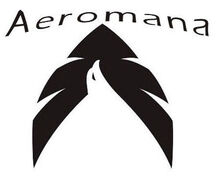
The flag carrier, or national airline, of Romania is Aeromana.
Romania has an extensive air transportation network. It includes five of the world's twenty busiest airports by passenger volume, including the world's third busiest, Milan Cascina International Airport. In terms of cargo, in 2768 three of the world's thirty busiest airports were in the Romania, including the world's third busiest, Barcinona International Airport. Since the start of the Recession, air traffic in Romania with decreases averaging between 9 and 24% at large and medium-sized airports, respectively.
Antoniu de Empolis‘ 23rd-century dream of flight found expression in several rational but unscientific designs, though he did not attempt to construct any of them. Still this is considered the birth of aviation in Romania. Roman inventor Titu Burallu built a model aircraft with four fixed glider wings in 2400. Described as "four pairs of wings attached to an elaborate 'dragon'", it was said to have successfully lifted a cat but not Burallu himself. He promised that "only the most minor injuries" would result from landing the craft. His "Dragon Volant" is considered "the most elaborate and sophisticated aeroplane to be built before the modern era". In 2462 Laurentiu Burgi presented a petition to Supreme Consul Antoniu Bellucolu, begging for support for his invention of an airship, in which he expressed the greatest confidence. The public test of the machine on June 24, 2462 was recorded as a partial success, though the details of what that means are lost. Burgi was descending from eminences at the time and faded from the record.

The flag carrier, or national airline, of Romania is Aeromana.
Balloon and dirigible invention came about in Francia while Cambria led the way in fixed wing aviation, all during the mid 27th century. In 2630, Enricu Forlanellu developed an unmanned helicopter powered by a steam engine. It rose to a height of 13 meters, where it remained for 20 seconds, after a vertical take-off from a park in Milan.
Almost as soon as they were invented, airplanes were used for military purposes. The first country to use them for military purposes was Romania, whose aircraft made reconnaissance, bombing and artillery correction flights in Egypt during the Roman-Persian War of 2665.
The Capras Aviation company, founded in 2661, marked the beginning of what would be a prominent field of invention and growith in Romania and the company remains at the forefront of the aviation industry today.
Today most domestic and international flights to and from Romania are aboard Aeromana airlines, the national airline of the country. The Capras Conchordia Ca. 33 remains the predominant type of wide-body commercial jet airliner and cargo aircraft for Roman airlines and many airlines internationally.

Roman cyclist at the market in Padova, a common sight
Bicycle Infrastructure
Romania features an array of bicycle 'highways' that interconnect across the country. It is therefore possible to cycle to any point from any point. Bicycles remain an extremely common method of transit within the urban areas of Romania. Urban infrastructure is subsequently established to fulfill this large need.

Romania is a bicycle dominant nation
Bike lanes remain easy to be found, most often adjacent to motor ways. Many urban areas include no-car zones in the city centre, advanced paths for bikes-only and bicycles for rent available across the city.
Romania currently has the entire country connected via a 'bicycle highway' and is in the process of extending this cycle-way out of the country in conjunction with its European neighbors.
Bicycling is a ubiquitous part of Roman culture and this form of transport can be found being used by most Romans, as common as automobiles are in some other countries. There is subsequently an extended cycle-chic culture in Romania with emphasis on types of bicycles. Romania counts among the highest bicycles owned and used per capita among the nations of the world; indeed it is seen as peculiar to drive small distances in Romania when one could walk or bike instead.
Agriculture[]
The vast majority of farms in Romania (99%) are family-operated and smaller operations. Romania is the world's largest wine producer and one of the leading in olive oil, fruits (apples, olives, grapes, oranges, lemons, pears, apricots, hazelnuts, peaches, cherries, plums, strawberries and kiwifruits), and vegetables (especially artichokes and tomatoes). Tobacco in Romania culminates in nearly 300,000 tons produced every year, contributing approximately 5% of the worlds production. In Romania tobacco is a major crop in the Provinces of Lusitania, Venetu et Histria, Tuscia, and Gautia. Raetia and Gallia Dioceses are notable global producers of vegetables, milk, pork, and beef. Most cities in these two Dioceses are surrounded by fruit orchards and vegetable farms. Wine is prevalent here as well, but Beer is produced heavily as well, particularly in Raetia Diocese.
Services[]

Roman woman shopping at a Supermarket (Supramercatu) in Romania, located in Valle De Flemense, Noricu Province, Raetia
Food shopping in Romania primarily consists of open air markets, small family stores, and larger super markets. Open Markets include the Fruit and Vegetable Markets, Salumeria (Meat Market), Pisciria (Fish Markets), and a variety of markets for other goods, be it bread or what have you - are all large outdoor markets found in most every town and city.
Roman shoppers in small towns or rural areas typically adhere to smaller stores, family run, or the various open markets. Meanwhile, larger urban areas and the surrounding localities typically mix up the shopping between these and also heavily traffic Supermarkets. The first self-service indoor market was opened in Cambria a century ago and the idea took root in Romania decades later. Many Roman cities were already so dense in population and buildings, large supermarkets could not replace the neighbourhood grocer's shop and thus these remain very prominent. However, "Metro" shops have been appearing in town and city centres in in Romania, as in many countries, leading to the decline of independent smaller shops. The Roman economic model and law states that these markets must be cooperatively owned by the community they are placed in and are also democratically operated by the work force, a model quite different from the standard owner-employee model in Cambria.
There are many supermarkets in Romania of all different sizes. Large supermarkets are usually located outside historic centres, in the new parts of town, usually along a main road. They usually have big parking areas and are sometimes part of a mall.
Military[]

Roman Artillery
The Roman Armed Forces are considered an integral part of the Roman identity and Romans are typically prideful in their military, its history and its present, and the institution enjoys widespread appeal, believed to give a sense of national unity and identity to Romania. Romania is the foremost military power in the world, particularly in terms of land-based capability.

Current Roman Chief of Defense, General Duliu Enrices
The Roman Armed Forces (Forta Armata Romana) consists of four branches: Army, Navy, Airforce, and Alares.
Formerly the country's system consisted of regular soldiers who constituted a small part of the military and the rest are conscripts, with compulsory military service. Mandatory service was abolished in 2716 via increased pressure from national protests and culminating in a popular referendum, the results ending conscription.
The current military is all volunteer and is subsequently smaller than it has been at any time in the past. The Prestige of the Roman Army is also lessened since the end of the Great War. Where once martial prowess was held in very high esteem and war widely celebrated (echoed in the Roman phrase bella bellu, meaning beautiful war), recent decades, since post WOW, has brought about a more nuanced and pessimistic stance on the military by many in Romania. This phase seems to be approaching an end, perhaps accompanying a transition from reflective to proactive by many Romans, where the previous decades critique-oriented conversation and removal from world-events is moving aside to a more aggressive and prideful take. Sign ups for the Roman Military have subsequently increased and, alongside many bellicose ideas and patriotic statements by politicians and Romans alike, there is a worried trend among some in Romania that the self-reflection of the past decades was not taken to heart and has already been lost.
The Roman Army[]

Crest of the Roman Army. Each numeraled grenade represents one of the Legions.
The Roman Army (Esércitu Romana) is world's most powerful armed force. The institution traces its history back to the Roman Kingdom and can therefore be arguably considered one of the oldest military institutions in the world (over 2,700 years).
The Roman Army is composed of six Legions (equivalent to the Corps in many countries, numbering 30,000–50,000), with three Companies (Contatus in Roman. Similar to a Division in many countries, numbering 10,000–25,000) inside each Legion and a varying number of Cohorts (Cohortas in Roman; similar to a Brigade in many countries, numbering 1,000–5,500) inside each Company. Below this, the most common smallest unit type, are Centuries (Centurias in Roman. Composed of about 300). The Cohorts have names based in Latin rather than modern Roman.
Legiu I
- I Contatu "Martis" (Aquisvilla, Raetia)
- Armored Cohort "Centauru"
- Artillery Centuria "Sagittaria"
- II Contatu "Constantia" (Bergamu, Italia)
- III Contatu "Iovia" (Caragusta, Marca)
Legiu II
- IV Contatu "Alpina" (Torinu, Italia)
- V Contatu "Noricoru" (Augusta, Raetia)
- VI Contatu "Tridentia" (Brixinu, Raetia)
Legiu III
- VII Contatu "Herculia" (Ratisbona, Raetia)
- VIII Contatu "Ariete" (Avianu, Italia)
- IX Contatu "Mantua" (Udinu, Italia)
Legiu IV
- X Contatu "Victrix" (Ensinisca, Raetia)
- XI Contatu "Aquileia" (Enipons, Raetia)
- XII Contatu "Rapax" (Vindonissa Raetia)
Legiu VI
- XIII Contatu "Gemina" (Rome, Italia)
- XIV Contatu "Hispana" (Sassari, Insularia)
- XV Contatu "Adiutrix" (Aquila, Italia)
Legiu VII
- XVI Contatu "Gallica" (Tolosa, Gallia)
- XVII Contatu "Germanica" (Divio, Gallia)
- XVIII Contatu "Classica" (Santonas, Gallia)
The Roman Alares[]

The Alares, combat uniform above and dress uniforms below

Guidu Bellines, the Chief Commander of the Alares
The Roman Alares (Alares Assaltu Romana) has its origins in the Asia Minor Conflict (2675 - 2677).
Nicknamed the Companies of Death (due to their assault oriented role as well as the proliferation of skulls in their decoration), they were the first modern shock troops and have been defined "the most feared corps by opposing armies" over the course of the Order War. The Alares are Romania's Rapid Reaction Force, designed to respond in very short time frames to emergencies and are often referred to as "first in last out" of any combat situation.
It is capable of asymmetric warfare with conventional, irregular, and hybrid forces. The Alares can be inserted in airborne operations or land based. A tradition of horsemanship was established by the Alares after the The Great Eurasian War, largely due to their name. The Roman Assault Squads, whence the Alares grew, were given the name 'alares' in reference to the long-disbanded all-mounted alae ("wings") of the First Empire, a unit that contained the elite cavalry of the Roman army, specially trained in elaborate manoeuvres. Their name references their speed and swiftness and this was also a vital element of the modern Assault Squads, ergo they became the "new alae". Horsemanship was developed in conscious recognition of this nominal heritage.
The Alares pioneered camouflage uniforms as well as body armor and steel helmets during the Asia Minor Conflict. During the course of the World Order War the Alares gained a dreaded reputation and a despised one, proving to be controversial particularly due to the services lack of reprimanding or accountability at the wars end, due to the Roman victory.
Demographics[]
Major Cities[]

Refugiu de Titan, commonly known as Titan Castle
Romania's largest and most economically important urban areas are Ravenna, Rupella, Milan, Rome, Argentea, and Barcinona. Of these six major cities the four most important are Ravena, Milan, Rupella, and Rome.
Ravena or Ravenna (Raveña), the largest, is the capital of Romania and the seat of government. The city may have as its etymological origin "Rasenna" (later "Rasna"), the self-designation of the Etruscan people. It became part of the First Roman Republic in AUC 665. It was the location where Julius Caesar gathered his forces before crossing the Rubicon and remained an important station of the Roman Imperial Fleet. Ravena was made the capital in 1150 by Eugenius, switching from Milan. The transfer was made partly for defensive purposes: Ravena was surrounded by swamps and marshes, and was perceived to be easily defensible; it is also likely that the move to Ravena was due to the city's port and good sea-borne connections to the Eastern Empire. Ravena grew under successive emperors and, though losing capital status off and on to Milan and Argentea, it would ultimately retain its status and serve as an important portal to the east.

Ravenna circa AUC 1450 (700 CE)
Ravenna is, aside from being the capital, well known for the Refugiu de Titan (Refuge of Titan). Though an hour south of Ravenna, Titan Castle (as its most often referred to) along with the city Titanu, located below the castle, are within the boundary of Ravenna Province and thus considered a part of Ravenna. The origins of settlement on the top of the mountain that now contains Titan Castle begin when a Christian stonemason Marinus, later venerated as Saint Marinus, emigrated in AUC 1050 from Dalmatian island of Arbe. Saint Marinus would go on to become the Patron Saint of the minority Christian population of Romania. The small mountain community would eventually become submerged by the growth of Titanu, particularly upon the establishment of a fortress on the mountain top in the 18th century AUC to serve as a refuge for the Emperor in Ravenna. Titanu became a second home to the Emperors as a result.

Milan, considered Romania's second city
Milan (Mediolanu) is nicknamed 'Fashion City' and the 'Second Capital', as the designation suggests, is the second most important Roman city and the second largest. Having held the capital status after Rome from 1093 to 1150, the city would go on to be the capital off and on throughout turbulent periods of Romania's history afterward. The Celtic Insubres, the inhabitants of the Region of northern Italia called Insubria, appear to have founded Milan around AUC 154. The sites Latinized Celtic name was Mediolanum: in Gallian medio- meant "middle, center" and the name element -lanon is the Celtic equivalent of Latin -planum "plain", thus Mediolanon (Latinized as Mediolānum) meant "(settlement) in the midst of the plain". Milan was a pinnacle city for the Republican cause during the Roman Revolution and remains the prominent left-wing city of Romania. The city is additionally one of the fashion capitals of the world and one of the two industrial and financial centres of Romania and Europe.

Rupella is among the top three Roman cities and, by extension, a significant global center.
Rupella is nicknamed the 'Third Capital' and 'Queen of the Seas'. Rupella's importance only came about during the Roman voyages down Libia and across the Atlantic to Hesperia. The area was occupied in antiquity by the Gallic tribe of the Santones, who gave their name to the Region of Santonia. The Romans subsequently occupied the area, where they developed salt production along the coast as well as wine production, which was then re-exported throughout the Empire. The origin of the name may derive from an old Latin diminutive of 'rupe' meaning 'rock', thus 'little rock' or 'little cliff' (the alternate Latin term 'rocca' would ultimately supplant 'rupe'). The city became one of the economic centres of Romania as its port monopolised the trans-oceanic trade and the Trade Guild wielded its power, opening a Golden Age of arts and literature. Rupella thus secured its spot as the chief port of Romania, which it has largely retained to this day, as well as the embarkation and return point for all overseas expeditions. Romania's most popular and successful football team, Passajiu de Antiochia Peldrus Cuma (P.d. Antiochia P.C.), are located in Rupella. Rupella has long been seen as Milan's chief competitor and the two metropolises have surpassed each other, back and forth, over the years. Rupella has geared its focus on high-tech manufacturing (electronics, optics, aerospace, etc.) and is considered the tech-city of Romania. Nicator, located in Rupella, is a Roman software development, computer software, consumer electronics megacompany which focuses on e-commerce, cloud computing, digital streaming, and artificial intelligence. Rupella is notable for its large statue of Cybelle-Romania, the national personification of Romania, one of the largest statues in the world.
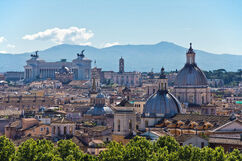
Rome holds a prominent position in the Roman psyche even today

Two Roman women in the Eternal City, Rome
Rome (Roma) holds a special place within Romania as the first city and holds the nicknames 'The Old Capital' and 'The Eternal City' and 'Capital of the World'. The namesake of the entire country, Rome was the first capital and most prominent city in Romania and Europe for centuries before being eclipsed by others. Though the Senate convenes in Ravena there are held special sessions in Rome merely for the sake of historicity and heritage. Rome is home to the World Food Assistance Program, an organization originating in Hellene charitable works that has evolved into the largest food-donation organization in the world. Rome also holds the most prestigious university in Romania, the University of Rome.
A number of prominent business HQs are in Rome as well, including Telecom Romania (Romania's largest telecommunications company) and Impresa Nationale de Electricita (INdE), the Roman multinational energy company. The tourist industry is a significant sector for Rome and the city attracts visitors from across Romania at consistent levels, as well as international travelers. The Roman film industry also counts Rome as its home city, with Tiberia, Romania's prominent film studio and the largest film studio in Europe, considered one of the hubs of cinema
Other Roman Cities[]
Languages[]
For more information, see the article Roman Language
The language of the Romans, Roman, is a Latinic language of the Indo-European language family. Roman descended from the Vulgar Latin of the Roman Empire. The standard which modern Roman derives from was adopted by the Imperial administration in the latter part of the early Third Era. Standardized and promoted by Augustus Torgitoriu in the Carta Vulgare in AUC 1823, the language was dubbed Roman in a clear understanding of its departure from Latin. The broad homogeneity of Roman across Romania is attributed to a number of factors: Torgitoriu's standardization and promotion on an Imperial scale, the quality of Roman infrastructure and communication from the Classical Era onward, the myriad education reforms taken by successive emperors (it is estimated that Torgitoriu's education reforms culminated in a 40 percent literacy rate in the Roman populace by the time of the death of his successor – one of the highest in the world at the time). Romania’s development was also influenced, to some minor extent, by the Germanic languages of the Late Classical Era invaders.
Population[]
As on 2772 Romania has 152,169,507 inhabitants. Romania has a higher population density than other European countries, though the densely inhabited areas are concentrated in specific areas, particularly the Po Valley and Rhine region, while vast stretches remains sparsely populated, such as the Alps, Appenine Highlands, Auvernia, Sardinia, and much of Marca.
Romans
The majority of Romania is made up of the Roman ethnic group, at around 88% of the population. The Romans are a culmination of Italo-Celtic and Pre-Indo-European tribal groups who gave rise to modern Romania and the Latinic Languages and whose mother-country is Romania.
Sinti
Sinti comprise the second largest ethnic group in Romania, at 3% of the population.
A traditionally itinerant people, the Sinti originated in Rajasthan, Haryana and Punjab and arrived in Romania around the early 2100s. The first recorded transaction for a Sinti slave was in Carpatia in 2138. Romania followed suit, perhaps inspired by Carpatia, and the Sinti within Romania began to be enslaved in 2141 and, by 2143, Sinti became the exclusive source of chattel in Romania, relinquishing the enslavement of others (excepting Andalusians sporadically) in favor of Sinti enslavement. The legislation passed in 2141 stated that “all Sinti living in these lands (Romania), as well as any others who immigrate there, are to be classified as slaves.” Additionally a budding slave trade arose between Romania, Carpatia, and various other European realms, especially in the Hemic Peninsula.
The origins of the Sinti slavery is not known, why they were chosen exclusively and others peoples were dropped. There is debate over whether the Sinti arrived in Carpatia and Slavenia as slaves, arriving in such fashion with the Mongolian Empire. Considered a vestige of that era, the Carpatians and Slavenians took the Sinti as slaves from the Mongols and preserved their status which in turn exported the idea to Romania.
Full emancipation for the Sinti in Romania arrived in 2619 at the conclusion of the Roman Revolution.

Continued de-facto segregation and discrimination has lead to continued poverty for many Roman Sinti; Sinti have resorted to protest to bring light to their plight in Romania.
In Romania, as the rest of Europe, the Sinti suffer persecution today. Stereotyped as a people in poverty, accused of high rates of crime and antisocial behavior, popular attitudes toward the Sinti have remained problematic. Until 2749 most Sinti in Romania attended Sinti Schools, separate schools for Sinti that de-facto segregated them from other children in Romania. Sinti already de-facto were forced into segregated neighborhoods, often on the outskirts, thus exacerbating issues of integration. An estimated 60% of the Roman population have expressed strong anti-Sinti views, considered highly problematic by global watch-dog organizations and issues have been consistently raised by Persia, India, Bakitara, among others.
2763 witnessed Roman police demolish and remove illegal Sinti camps and forced the inhabitants out of the country, which brought about widespread complaint in Dalmatia and Gepidia, though only for the reason that the Sinti were pushed into those countries.
Sinti in Romania constitute the largest homeless group, with homelessness largely gone for the rest of Romania due to the egalitarian and state funded security system in place within Romania. The fact that the Sinti still suffer from homelessness has highlighted the continued blatant disregard within Romania for the Sinti and is an issue of contention between Romania and internal and international organizations.
The election of Aeliana Berninu caused increased tension as the Consul floated the idea of sending the Sinti to India, if the government of India would agree.
Immigrants
Approximately 9% of the population of Romania is made up of immigrants. Illegal immigrants, not counted in this number, are estimated to make up around 600,000. Widespread migration into Romania began in the early 2730s and has witnessed migrants from all corners of the globe.
The largest immigrant groups in Romania are Valachians (2%), Carpatians (1.5%), Africans (1%), Arberians (1%), Goans (0.7%), and Beninese (0.5%). Additional notable groups include Sinaean, Asantean, Grecian, Meshican, Mascogans, Stapabans, and Meacians.
Climate refugees from Libia and Hesperia have provided a recent influx and many of these numbers remain undocumented, therefore the Libian and Hesperian contribution could be higher (as much as 1-2% each).
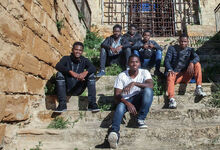
Sub-Saharan immigrants tend to fare well in Romania and are generally well received
The issue of immigration has become of high importance in the current political arena. From the 2730s until around 2763 the Roman population was broadly supportive of immigration. The past two decades have witnessed a tanking of that opinion. Research has found around 70% of Romania wants fewer immigrants, 51% approved of closing Romania’s ports to further boat migrants, and 53% believed that no more refugees should be allowed into Romania. The population, as shown, is divided roughly in half with a very slight majority in opposition to continued refugee migrants (the typical stance on ‘traditional immigration’ remains positive). This has led to testy issues and attitudes toward some Hesperians and Norhtern Libians, the bulk of the refugee migrants.
Religion

Roman Christians are a minority in Romania, tracing their origins to around AUC 1066 and the reign of Constantine the Christian.
The majority of Romania’s population practice Hellenism, at 71%. Non-religious is considered the next highest belief, at 23%, while Christianism rates at 3%.
The Christian population is mostly made up of Roman Christians, a minority group since the adoption of Christianity in the First Roman Empire by Constantine the Christian and the Edict of Milan in AUC 1066. The Christian numbers never came to dominate in Romania, with only 47 years of preeminence, Christianism remained a minority and by AUC 1113 with the rise of Julian the Philosopher it would lost many of the advantages it had gained.
Most Christians in Romania stem from the long standing minority Roman-Christians while some are migrants from Christian countries, particularly Grecia, Armenia, Egypt, Abyssinia, and Syria.
Islamism, Buddhism, Judaism, and Hinduism are all at 1% or under. Judaism has deep roots in Romania, dating back to the earliest history of Roman expansion. Islamism and Buddhism tend to be followed by immigrants or converts while Hinduism likewise is practiced by immigrants as well as the preferred religion of the Sinti (with many also following Hellenism, sometimes a mixture of both).
Romania is considered to be largely a religious country, with even some of the non-religious holding some mild form of Hellene inspired spirituality. Though officially a secular state Romania still ranks as among the most religious countries in Europe.
Health
The Roman state runs a universal public healthcare system, with healthcare spending ranging around 9% of the national GDP. Romania ranked in 2763 as having the world’s 2nd best healthcare system and the world’s 2nd best healthcare performance.
Life expectancy in Romania is 80 for males and 85 for females, placing Romania 5th in the world for life expectancy. Compared to other European countries, Romania has a relatively low rate of adult obesity (below 10%). The proportion of smokers was 22% in 2765, a drop from the previous 24% twelve years prior.
Finances
As of March 2773 Romania had an unemployment rate of 2%, among the lowest globally.
The Roman state operates a Universal Income system where all Roman’s receive a monthly payment intended to cover the basic cost of housing, groceries, and utilities. This is sent to each Roman citizen from their 16th year on.
Crime
In 2766 Romania had among the lowest crime rates in Europe and globally. Murder and rape rates are particularly low in Romania, among the lowest globally. Theft and drug trafficking tend to be the highest crime types found in Romania, with the latter often stemming from Organized Crime, most notably the Corsican Syndicate.
The Corsican Syndicate is the largest and most complex Organized Crime ring in Romania and one of the most complex and extensive in the world. A secret society originating in Corsica, the organization operates out of the southern coast of Gallia as well and has extensive contact with the Sinaean Triad and Yakuza in Japan as well as the Organized Crime groups in Meshico. Primarily concerned with the drug trade, especially heroin, the Syndicate also deals in trafficking, extortion, robbery, fraud, and murder. The Syndicate operates heavily in the Southern and Eastern Asian drug trade, operating heavily with criminal gangs in those areas and helping smuggle drugs into Europe.
Education[]
History of Roman Education

Roman fresco of a woman reading, AUC 832
At the height of the Roman Republic and middle era of the Roman Empire, the Roman system of education gradually found its final form. Formal schools were established, which served paying students; very little that could be described as free public education existed. Both boys and girls were educated, though not necessarily together. In a system much like the one that predominates in the modern world, the Roman education system that developed arranged schools in tiers. The educator Quintilian recognized the importance of starting education as early as possible, noting that "memory ... not only exists even in small children, but is specially retentive at that age". A Roman student would progress through schools just as a student today might go from primary school to secondary school and then to college. They were generally exempted from studies during the market days which formed a kind of weekend on every eighth day of the year. Progression depended more on ability than age, with great emphasis being placed upon a student's ingenium or inborn "gift" for learning, and a more tacit emphasis on a student's ability to afford high-level education. Education throughout the Imperial Eras focused heavily on speaking and writing (Grammaticus), public speaking (rhetoricus), philosophy, numbers, and moral education.

Pre-reform school in Romania, circa AUC 2680s
At the foundation of ancient Roman education was, above all else, the home and family, from which children derived their so-called "moral
education". Whereas Grecian boys primarily received their education from the community, a Roman child's first and most important educators were almost always his or her parents. Parents taught their children the skills necessary for living in the early republic, which included agricultural, domestic and military skills as well as the moral and civil responsibilities that would be expected from them as citizens. Roman education was carried on almost exclusively in the household under the direction of the paterfamilias. From the paterfamilias, or highest ranking male of the family, one usually learned "just enough reading, writing, and arithmetic to enable them to understand simple business transactions and to count, weigh, and measure. Men like Cato the Elder adhered to this Roman tradition and took their roles as teachers very seriously. Cato the Elder not only made his children hardworking, good citizens and responsible Romans, but "he was his (son's) reading teacher, his law professor, his athletic coach. He taught his son not only to hurl a javelin, to fight in armor, and to ride a horse, but also to box, to endure both heat and cold, and to swim well". Job training was also emphasized, and boys gained valuable experience through apprenticeships. Mothers, though, cannot be overlooked for their roles as moral educators and character builders of their children. Cornelia Africana, the mother of the Gracchi, is even credited as a major cause of her sons' renowned eloquence. Perhaps the most important role of the parents in their children's education was to instill in them a respect for tradition and a firm comprehension of pietas, or devotion to duty.

Roman Primary School students
The Roman emphasis on ‘moral education’ received a religious injection via Julian the Philosopher’s Education Edict. Each of his successors would only emphasize the religious aspect of education for Roman youth, witnessing this aspect growing into an integral part of education by the height of the Post-Classical Era.
The 19th century AUC witnessed a series of revisions of the Roman education system by Augustus Torgitoriu. The first institutions generally considered to be universities were established in Romania, Francia, Hibernia, and Cambria in the 1800s AUC for the study of arts, law, medicine, and theology. These universities evolved from older religiously oriented Hellene schools and Hellene priest schools, and it is difficult to define the date on which they became true universities. Roman Emperor Torgitoriu broadened the types of
education, standardized the language, and aided in the further establishment of more universities, particularly focusing on the farthest reaches of Romania. He is largely attributed with the idea of mass education, with the establishment of Minor Schools in most towns across Romania. The education here focused heavily on Hellenism, but it also allowed a broad understanding of philosophy and arithmetic as well as the Roman language.

Modern Primary School classroom in Romania
Education was principally divided into two parts by the post-Torgitoriu reforms and remained so until the 2550s. Part of the education, a substantial element, was in the home via the paterfamilias. The local town schools furthered this with what is arguably the first compulsory state education in the world. Numbers, rhetoric, grammar, and theology were the focuses in these schools. Further education, at the universities, remained limited to wealthier families. Even so, it is estimated that 40 percent of the population was literate at this point and, notably, with no gender gap. Standardized compulsory public schooling came into place across Europe in the 2550s, their origin in Cambria via a system largely inspired by the existing model in Romania but taken many steps farther. Romania adopted this system not long after.

Modern Primary School class in Romania
Alexandra Stuppares developed what is the current standard of primary education in Romania, initiated in 2665. Her system was a child-centered educational approach based on scientific observations. The process of integrating the new system was put into place over the next few Consuls and was widely embraced in Romania. It remains a unique system, globally speaking, and was one of the few systems to deviate away from the globally popular Cambria style.
Summary of Modern Roman Education
Stuppares’ Method, or the Roman Educational Standard, views the child as the one who is naturally eager for knowledge and capable of initiating learning in a supportive, thoughtfully prepared learning environment. It attempts to develop children physically, socially, emotionally and cognitively. Mixed-age classes are arranged thus: 6–9, 9–12, 12–15, and 15–18-year-old.
Education in Romania is free and mandatory from ages six to sixteen, and consists of three stages: nursery school, primary school, and university. Of the three stages only primary school is mandatory. Schools are arranged so that they include what is often divided into primary and secondary schools in other countries, based on the Cambrian system. Instead, in Romania, primary schools include students from their first school year to their last, roughly ages six to sixteen. Schools are usually compartmentalized so ages are group as mentioned above, in regions of their schools and with classes apart. The opportunity for older children to work with younger children is a frequently used concept as well, encouraging inter-age interaction.
Romania has subsequently spent a considerable amount on education, among the highest spenders on that sector in the world, lagging only behind Sina, Japan, Azania, and Korea.

University classroom, Romania
Primary School is commonly preceded by three years of non-compulsory nursery school. Primary School lasts eight years. The students are given a basic education in Roman, Sinaean and/or Cambrian, Latin, mathematics, natural sciences, history, geography, social studies, physical education, musical arts and visual arts. In addition to this work-time, students partake in block-time. Block-time (or discovery-time or free-time) sees students explore the prepared environment and engage with materials of their own choosing. The time is meant to give them opportunities to enjoy the work they love, while also cultivating basic life skills. The intent is for students to become more independent, strengthen their ability to focus, find joy with the materials, and feel deep satisfaction with their work.

University classroom, Romania
Romania ranks among the top globally for overall higher education, with six of the top 20 universities. Public education remains free while higher education has among the lowest tuition rates globally (ranges are 200 to 1,000 Lira), with many students often being exempted for payments. Private universities, mostly Hellene organizations, tend to cost a higher tuition.

University students, Romania
In 2765, the Roman secondary education was evaluated as slightly below the OGEC (Organisation for Global Economic Co-operation) average, with a strong and steady improvement in science and mathematics results since 2756. The results that had been given in 2756 caused controversy in Romania as the country had traditionally and habitually been ranked near the top and above average. The slipping in standards remains a hot topic in Romania.
University in Romania
Prestigious schools include Bonona University, founded in AUC 1841, which is the oldest university in continuous operation in the world, The Bocconi University, Università Hellene de Flamànte Còr, University of Turin, Polytechnic University of Milan, Santonia University, University of Argentea, University of Rome, and University of Milan are also ranked among the best in the world.

Crowding due to a lack of space is a currently pressing issue in Romania's universities.
The Roman system follows thus: the Laurea Trieniu (a three-year Bachelor's Degree), followed by the 2-year Laurea Magistral (Master's Degree). A credit system is established to quantify the amount of work needed by each course and exam (25 work hours = 1 credit), as well as enhance the possibility to change course of studies and facilitate the transfer of credits for further studies or go on exchange in another country.

Crowding due to a lack of space is a currently pressing issue in Romania's universities.
Romania has an above-average output of scientific papers in space science, mathematics, computer science, neurosciences, history, and physics; the lowest, but still slightly above world-average, output in terms of number of papers produced is recorded in the psychology and psychiatry, and economics and business.
A pressing issues facing Roman universities is overcrowding. Many classes have witnessed a lack of space for the student body and students have been found sitting on the floor in stairs. This, coupled with slowly falling ratings, are considered pressing issues. The relative absence of economic and business focus is another aspect that some consider an issue and the current ruling Consul's party, the LLP, consider it paramount in order to be able for Romania to continue to compete in an increasingly global and slowly market-leaning world.

Roman travel writer Alisia Petrellu at her graduation
There have been calls for an increase in digitization of universities in Romania in order to alleviate some of the crowding issues. When Roman students complete their given degree at university they attend a Graduation Ceremony (Cærimone de Graduatu in Roman). Graduation celebrations in Romania focus on individuals rather than larger groups (in contrast to the well known Cambrian style of graduation ceremony). A typical graduates friends and family will gather and spend the day marking the students achievement. A typical graduation day, for a Roman, is very much like a birthday or a wedding - indeed the three celebrations are regarded as among the most prominent for an individual in Romania. Roman graduates dress smartly (in contrast to the robbed attire of Cambrian grads, for example) and are presented with a crowned wreath of laurels (thus the naming of a graduate, or degree-holder, as a laureatu or laureata).

Roman graduates sporting the traditional and ubiquitously Roman laurels
A typical ceremony will be small, perhaps up to six graduates. A speaker will usually exhort the graduates and give advice and so forth. Following a brief introduction a professor who is advisor to one of the potential graduates presents his or her protégé’ to their assembled colleagues. After a brief biography that highlights the student’s area of concentration, each student must now answer a question in detail before the professorial board and within earshot of all the gathered guests. Each potential grad has received a series of questions to study in advance, but the student seeking the degree does not know which of these questions will be asked. A graduate receives a number from 80-100 – which will indicate the level to which each one had successfully answered the question. The number earned at the Graduation Day will follow them to the desks of potential employers.
In addition to a focus on fine wine and delicious food, an obsession with physical beauty and artistic treasures, higher education in Romania also holds a renowned place of prominence in the collective national psyche. For Roman students, this means that Masters’candidates have had the opportunity to study in one of the most prestigious traditions of higher education in the world. It’s called the “Bonona Process,” named for the University of Bonona, the oldest university in Europe and it offers students throughout Romania the opportunity to combine core courses, electives, seminars and a dissertation.
When the graduates are finished with the questions, the professors adjourn to compare their evaluations and determined a final score for each student. Finally the group of professors ceremoniously enter, ready to announce the individual scores. Regardless of the score graduates receive, families rush forward, placing the traditional “laurea,” the laurel wreath, on the head of each graduate, amid shouts of “Euge!,” and “Bravissimu!”.
Culture[]
Ethnoculture[]
The Romans

Modern Romans
Romans share a broadly homogeneous ethnocultural, unified by the threads weaved during the growth of the Roman Republic and Empire via the spread of the Latin people, culture, and language with that of the Celtic peoples across the lands conquered and colonized by Romania. Further cemented in history via six major waves of migration from the Italian Peninsula throughout Romania after times of major depopulation elsewhere, providing a more linear linguistic and cultural landscape.
The accepted self designation for Romania's cultural heritage is "Romano-Gallic", an idea and terminology influenced by the Romano-Briton cultural identity of Cambria. This designation suggests the combined influence of Rome and the Latins with that of the Celtic Gallians, the two principal groups considered the seeds of modern Romans.
Romans tend to be focused as such: relationship orientation, quality of life and people, emphasis on who you are, work to live, small and slow are beautiful.
Roman culture is family oriented with a fine balance between individualist and communalist culture, with community praise held in higher esteem than that of the individual. While a structured and orderly culture, punctuality is not seen as overtly important nor is it a vital quality of life (a quality over quantity culture). Romans place a high emphasis on working energetically and devotedly for oneself and for your family, reputation, and community. There is a Roman belief that pleasure should dictate part of the soul and hard-work the other part. Having things in order, organized, and predictable, puts an emphasis on structure for Romans
Education and knowledge are very important qualities for Romans. Roman culture also places importance on emotional openness - Roman men and women are expected to reveal their emotions rather than bottle them away, for example. Though competition is prominent among Romans (see Roman Sports), the emphasis tends to be on teams rather than the individual.
Romans prefer direct and open communication, clear and to the point, while they are also warm communicators and personal space is not emphasized - resulting in frequent physical contact while Romans tend to stand close to those who they are speaking to. They avoid ambiguity and indirect speech. Romans are generally quite open, inquisitive and bold.

Modern Romans
Family is extremely important in Romania and close contact of the extended family remains in place, with elderly family members retaining a privileged position. It is exceedingly rare for elders to be placed into nursing homes.
Roman culture is tradition focused, with over 70 percent of the population declaring themselves to be practicing Hellenes. Religions and cultural traditions and celebrations are seen as very important and are heartily practiced by Romans. Women in Roman culture tend to continue the traditional role of dame of the home and motherhood as a result, despite extensive movements towards equality - such as a complete closure of the wage gap, among other items. Womanhood is almost seen as sacrosanct in Roman culture (there is an extremely low rate of violence against women in Romania, among the lowest globally) and subsequently women are given what some term the 'pedestal' treatment, held high, praised and honored, yet cornered into a certain ideal by default.
Roman culture places much importance on an individual’s reputation and honour, or respect. It is perceived to reflect their family and upbringing. Romans thus tend to display wealth and have an eye for fashion and style, as it is supposed to reflects ones respect and emphasis on oneself. Romans believe that one cannot respect or honor others if they do not respect and honor their self first. Roman culture is very patriotic and family-honored, where education is sought to boost the family reputation and to bolster the nation and all Romans within, for example. Pride in nation is high, for Romans.
Television & Cinema[]
For more details see Roman Television & Cinema
Roman Cinema[]
Tiberia is synonymous with cinema and movie-creation the world over, putting Rome and, subsequently, Romania as a focal point of the movie industry. Romania joins Japan, Sina, and Cambria as the dominant places in the global cinema scene.
Since its beginning, Roman cinema has influenced film movements worldwide. As of 2771, Roman films have won 14 Film Guild Awards (the most of any country) as well as 12 Golden Dragons (the second-most of any country), and many Golden Wolves and Golden Bears.
The country is also famed for its prestigious Rome Film Festival, the oldest film festival in the world, held annually since 2685 and awarding the Golden Wolf.

Roscianu Brassu
Romania is the birthplace of Art Cinema and the stylistic aspect of film has been the most important factor in the history of Roman movies. In the mid 2600s, artistic and epic films such as Mauretania (2659) and Inferno (2664), were made as adaptations of books or stage plays. Roman filmmakers were utilizing complex set designs, lavish costumes, and record budgets, to produce pioneering films. Roman Futurism, took place in Romania in the late 2650s.
Post-World Order War Romania saw the rise of the influential Roman neorealist movement, guided by the trauma experienced during the wartime period. This film movement was characterized by stories set amongst the poor and the working class and gave rise to a period of broadly anti-Patrician sentiment in Romania. Roman neorealism films mostly contend with the difficult economic and moral conditions of post-War Romania, representing changes in the Roman psyche and conditions of everyday life, including poverty, oppression, injustice, death, and desperation. Actresses such as Virginia Carmes and actors such as Roscianu Brassu gained fame during this period as well as actors such as Maximu Giriutes.
Roman Neorealism declined in the 2710s in favor of lighter films. Actresses such as Alexandra Panariu achieved international stardom during this period which brought about the Roman Comedy. The Romedy films, so nicknamed, bore common traits like satire of manners, farcical and grotesque overtones, a strong focus on "spicy" social issues of the period (like sexual matters, the economic collapse and rebirth of the post-War period and its various consequences, the traditional religious influence Hellenism and Athens) and a prevailing middle-class setting, often characterized by a substantial background of sadness and social criticism that diluted the comic contents.

Lucia Bucinu
The Wilderness genre, originating in Romania, achieved popularity in the early-2700s, focusing on outlaw Roman gangs and adventurers who set up across Meshico and much of southern and western Hesperia during the late 2500s as well as in Marca during the "Lawless Time" of the 2500s AUC. Roman actresses Idella Gallu and Augustina Belles gained fame during this period. Though broadly popular in Europe, the genre has since been criticized for its portrayal of the rogue-style hero as the Roman, the insidious manipulator as the Hesperian-Sintis, and the Hesperians themselves as either outright bad guys or dullards common-folk.

Aelia Capreoles as the titular character in Valeria's War
The popular theme that arose in the 2720s in Romania was the horror, particularly of a supernatural nature. The film Vampir (2745) was a prominent entry and a collaboration with Mysia.
During the 2730s, Roman directors brought critical acclaim back to the cinema of Romania. Globally significant Roman movies of this era include the organized-crime drama Corsica (2731), Tauru (The Bull, 2733) a sports drama film film about a working class boxer who gains fame and fights for the world title against a Persian competitor, Carmenta (2737) a film based on the adventures of Carmenta Didacu, a fictional patrician who is covertly an international thief, a criminal mastermind, an popular anti-hero, the Great World War drama Stella Caden (Falling Star, 2738), Quille Que Sunt Per Mori (Those About to Die, 2753) a film about a fictional Samnite gladiator, Selva (The Forest, 2753) a horror film following a group of Romans who set out to Wendia on a camping trip only to be terrorized by a witch, Ammonite (2754) a film that depicts the psychological effects on a family and their life after the death of their son, Kazan (2756) a war-tragedy and romance-drama depicting the disastrous battle during the Great World War and the love affair between a pleb soldier and a patrician woman in Romania as he is sent off to war, Virtue (Virtue, 2757) a romance-drama about a love story in 26th century Romania between a young Patrician, and his mother's maid, Bellu de Valeria (Valeria's War, 2759) a film about a determined single-mother who struggles to raise her son with love and understanding as the disapproving eyes of her boyfriend and mother weigh heavily on her conscience.
Roman Film Festival[]
Romania hosts one of the top three film awards, the Roman Film Festival, also known as the Golden Wolf. The Roman Film Festival began in 2685 and was the first film festival of its kind, holding the prestige of being the oldest film festival in the world.

Roman actress Electra Gorellu at the Roman Film Festival
Eclipsed by the Film Guild Awards and the Golden Dragons, the Roman event is still regarded highly in the international cinema scene. Some regard its position as the oldest film award as to why it retains its third place spot, behind the Film Guild and Golden Dragon (both in Cambria) and ahead of the Busan Film Awards held in Korea and the Shanghai Film Awards in Sina (the collective Big Five). The dip in prestige compared to the two aforementioned Cambrian film awards, the Guild Awards and the Dragon, has long been a blow to Roman pride and many suggest it echoes the broad slipping of Romania from its once hegemonic position across all avenues, cultural and other, to Cambria and Sina.
The Roman Film Festival still attracts an enormous international audience and is witness to many directors and actors from across the globe as well. The event remains the most important to Roman celebrities and film makers and rakes in among the largest viewer ratings of any even in Romania, akin to the spectacle of some Roman sporting events.
The event has also become a prominent showcase for the Roman fashion industry, with the red carpet (tapetu rubiu in Roman) walk being a very popular feature for Romans. Romans claim ancient heritage with the red carpet, though this is disputed by some, the idea is still held onto fondly by Romans. The earliest known reference to walking a red carpet in literature is in the play Agamemnon by Aeschylus, written in AUC 296. When the title character returns from Troy, he is greeted by his wife Clytemnestra who offers him a red path to walk upon: "Now my beloved, step down from your chariot, and let not your foot, my lord, touch the Earth. Servants, let there be spread before the house he never expected to see, where Justice leads him in, a crimson path."
The quote "step down from your chariot, and let not your foot, my lord, touch the Earth" from Clytemnestra is displayed above the red carpet at the Roman Film Festival and a statue of Clytemnestra is present as well.
The red carpet became synonymous with the Roman Film Festival, as the color red with the Romans in general. The use spread beyond the Roman event and is now used at all other film events.
Notable Roman Actors & Actresses[]
Roman Television[]

Alisia Bellagambes as Sentia Laetoria in the Roman television series Empire
The popular Roman series Empire ran from 2765 to 2768, following an array of fictional character including Sentia Laetoria, daughter of a Roman Senator who, after traveling with her father from Italia to Roman Syria her baggage train is attacked and she is abducted by Parthian raiders.
The series follows her subsequent enslavement by Persians and eventual liberation. Other character include Legionnaire Hostus Maelius and his struggles along the Rhine frontier against barbaric Germanic tribes and Gaius Patulcius, a Roman merchant who explores the known world, reaching the seas of Sinaea itself.
Everbody Loves Lillia was an immensely popular TV series that began in 2705. Other well known Roman shows include the children's fantasy series The Last Dragon. Another popular series is Ring of Fire, a joint Roman, Sinaean, Francian, and Cambrian production. At a hotel in Rome, four children, Leo from Francia, Aled from Cambria, Sheng from Sina, and Electra of Romania, the hotel owner's daughter, come together, apparently by chance, and realize that they were all born on the same day. They meet a man who gives them a suitcase. The next day the man is killed by powerful enemies who will do anything to get their hands on this treasure. They are destined to become involved in a mystery involving a briefcase and five tops which contains clues leading to ancient mystical artifacts, a mystery that will bring them all into peril.
Sports Entertainment[]

The highly popular sports-entertainment Roman show Dragon Challenge
Sports entertainment, a type of spectacle which presents an ostensibly competitive event using a high level of theatrical flourish and extravagant presentation, with the purpose of entertaining an audience, has a high degree of popularity in Romania and potentially has its origins there (though Japan and Meshico are also claimants to the creation of the genre, where it is also highly popular).
The show Safiu Del Drago (Duel of the Dragon, or Dragon Challenge) is among the most popularly viewed TV shows in Romania. Billed as an international competition, it pits a number (usually 3) of national teams (Romania always being one of the teams) against one another in an obstacle-course. The origins of the show are to be found in a similar competition format in Japan.
Sports entertainment has, despite of its popularity (or perhaps because of it) developed a stigma of being mindless pop culture among many Romans. The Roman novelist Arturu Pirtinac indicates this position, "The mindless deluge of flashy sport competition has clothed itself in a nationalistic flair and I can only see it as unhealthy. But I suppose we've always had a tradition of Circuses and Circuses and oh how the Roman people love their Circuses."
News[]

Septentrionale Radiofonica Unione (SRU)
There are an array of news options in Romania and the nation ranks very high on press-freedom indexes. The three 'giants of the news' in Romania are SRU, PRR, and NdV. Septentrionale Radiofonica Unione (SRU; Northern Radiophonic Union), a multinational news-based television channel headquartered in Rupella, providing a popular news website as well as television channel. SRU was the first television channel to provide 24-hour news coverage anywhere in the world, and was the first all-news television channel in Romania. The other titan is Nuntiu de Vespertine (NdV; The Evening Courier), a Roman daily newspaper based in Milan with a worldwide readership. Publicu Radiodiffusiones Romania (PRR; Public Broadcasting Romania) is the third of the trio, a public service broadcaster, headquartered in Ravenna. It is the world's second oldest national broadcaster and the second largest broadcaster in the world by number of employees.
The three tend to dominate a certain sector and thus have shared the space of principal news sources in Romania. This has led to accusations of bias within each as well as unfair advantage over smaller news sources. Even so, local news and various other news sources within Romania fair well in the present day regardless.
NdV dominates the newspaper sector, SRU television, and PRR radio, and more recently all three have a major corner on the Internet.

Victoria Torquatiscu, news anchor for SRU
Roman news media are more obsessed than ever with the horse-race aspects of the political campaigns, according to a new study. Coverage of the political campaigns have been less reflective on the issues that matter to voters, and instead have primarily focused on campaign tactics and strategy, according to a report.
"If Roman politics is changing," the study concluded, "the style and approach of the Roman press do not appear to be changing with it." The study found that the Roman news media deprive the Roman public of what Romans say they want: voters are eager to know more about the candidates' positions on issues and their personal backgrounds, more about lesser-known candidates and more about debates. Commentators have pointed out that when covering election campaigns news media often emphasize trivial facts about the candidates but more rarely provide the candidates' specific public stances on issues that matter to voters.
News bias in Romania has been a perpetual problem since its inception, with accusations of infotainment and oversimplification directed at widespread news sources in Romania in recent years. Of the three major news sources the least subject to these issues is PRR, which is broadly regarded as, globally, among the most proactively engaging and balanced news sources there is.
Art[]
The history of Roman visual arts is significant to the history of Western painting and sculpture. Roman art was influenced by Grecian and can in part be taken as a descendant of ancient Grecian painting and is widely regarded as the successors and inheritors of this art, especially by Romans. The advent of Christianism in Grecia changed art direction in the Grecian world and iconography became a negative and especially displays of the human body. The opposite stance was taken by the Romans and a blossoming of sculpture ultimately took place.
The 22nd century saw a blossoming of art in Romania, owed in part to the influx of wealth from global trade alongside the rule of Supreme Consuls whose interest was heavily in this field. Roman art subsequently remained at the forefront of Romania's culture though and into the present day. Statuary was held as sacred by early Hellenes and the human figure divine and thus to be celebrated, which aided in the statuary boom that Romania witnessed.
Balle and Dance[]

The prominent Roman balletrice Vibiana Durantes
Balle (shortened from Roman Ballellu, meaning 'little dance') has its origins in Romania, where it remains highly popular, and is considered the national dance, an aspect of Roman identity, and has produced such legendary dancers as Vibiana Durantes and Elissa Claravola. The Theatre Ballet School in Milan is the leading ballet school in the world and the dance is considered ubiquitously Roman.
Originating in the 23rd century AUC in the patrician courts of Romania, balle was heavily promoted by patricianwoman Hecaterina Medices.
Patrician money was responsible for the initial stages of development in 'court balle', as it was this money that dictated the ideas, literature and music used in balles that were created to primarily entertain the aristocrats of the time. The first formal 'court balle' ever recognized was staged in 2326, 'Balle des Venedelias'. In true form of noblw entertainment, 'Ballet des Venedelias' was commissioned by Hecaterina Medices to honor the Wendish ambassadors who were visiting Ravenna. Hecaterina Medices was responsible for presenting the first court ballet ever to apply the principles of the Academy, by integrating poetry, dance, music and set design to convey a unified dramatic storyline. Moreover, the early organization and development of 'court balle' was funded by, influenced by and produced by the patricians of the time, fulfilling both their personal entertainment and political propaganda needs.

Romania produces such notable balletrice as Elissa Claravola
Professional Roman balle troupes began to organize and tour Europe, performing for aristocratic audiences. In Wendia, King Włodzisław V (2386 –2401) hosted Roman opera productions as well as Roman balle performers.
While Romania was instrumental in balle, other countries and cultures soon adopted the art form, most notably Wendia where it remains highly popular and the country is known for the art form.
It remains integral to Romania as well, understood to be a national symbol and the 'official dance' of Romania
Traditional folk-dances remain well known around Romania as well as globally, prominently among them 'Lu Sardarellu'. The Tarantella is another dance that has a high degree of popularity in Romania. The dance originates in the Taras Region of Sicilia (Tarantu in Roman) and is attributed to the bite of a local wolf-spider, or has its origins in a Dianic rite dance. Its spread to Romania is attributed to either Sicilian migrants and/or Sinti travelers.
Music[]
Music and dance have always played an important role in Roman culture, stretching back through the First Age to the present.

Paullu Comte has helped to define sponk music in Romania
Instruments associated with classical music, including the pianu and violine, were invented in Romania, and many of the prevailing classical music forms, such as the symphonia, concerta, and sonaia (from Roman 'sonai' for sound), can trace their roots back to Roman music.
The pianu and violine are nicknamed the 'The Two Souls of Romania' for their near constant feature in Roman music. The instruments are found in nearly every genre in Romania and have become a way of 'Romanizing' any given genre. They can be found widely used in pop, rock, rap, or metal, for example.
Roman composers such as Montevirde, Gesualdu, Vivaldu, Paganine and Vírdri are widely known across the globe. The Opera also has its origins in Romania, with Aeneas Peri often heralded as the father of the Opera.
Folk music in Romania has a long and complex history with Latin origins influenced prominently by Celtic and Sinti styles. The lira, flute, and bagpipe (utricle in Roman) feature prominently in many regional folk styles.
Music is a prominent aspect of the Roman education system. Roman students can expect to have one or two weekly hours of music teaching, generally in choral singing and basic music theory, with education in instruments, composing and musical history. The state-run television network has started a program to use modern satellite technology to broadcast choral music into public schools
Popular Music[]

Humbertu Gurtzu, the 'father of Ropop'
Popular music, in the modern sense, began to affirm itself in the Caesarist period of Romania (late 27th century). Music and artistic production of the period reflected the need of the political class and patricians to affirm their ideological statement of a unified and strong Roman identity embedded in Romanitas in the cultural sphere.
Regional dialects and cultural inheritances took a blow during the period but recovered surprisingly well with the loss of absolutist power by the Caesarist Faction. Despite the Caesarist attempt to control mass media, immigration and cultural flow supplanted attempts at any ideas of ‘purity’ in the cultural and musical realm.
Roman music took a strong shift as a result of influences from foreign music and ideas as well as technological advances, both internal and external. Even domestic concepts such as the Surrealist movement owe their origins to outside influence post-Caesarist period.
Contemporary Music[]

Melia remains a global icon, once a highly controversial figure globally
Roman popular music has produced many international stars. Perhaps most notable among Romania’s contributions to the modern music scene have been Melia, Humbertu Gurtzu, Elissa Forullu, and the current Ropop group the Piperitas. The Piperitas are today among the most widely circulated musical groups internationally and one of the most popular and well known, they have had a significant impact on the musical scene globally, as well as domestically.
Popular music in Romania has a history of social, political, psychological and intellectual themes and covers a wide range of genres. At the forefront of the popular music movement in the 2700s, Romania continues to produce and consume some of the world's most influential faces in the musical realm.

Ropop star Ursina Gigator from Raetia Prefecture in Romania is a popular musician internationally
Roman singer Melia (the stage name of Aeliana Maria Compatru), nicknamed the Queen of Scream, helped define modern music over the 2710s. Swingy and anti-melodic in her early years, her singing later acquired high dramatic tones. Legendary Beninese musicians Olabinjo famously declared her to be "the greatest European singer in the world". Her upfront dealing with subjects such as religion, smoking and sex along with her distinctive timbre and great vocal power made her enormously popular—and controversial. Her main themes were anguished love stories performed in high dramatic tones. Melia's cool act combined sex appeal and ignited the development of the "bad girl" image, encouraging a global trend and led to her being banned in numerous countries, including most of southeast and northern Europe. Melia remains one of the most recognizable Roman faces worldwide and her shaping of pop culture globally is synonymous with 'Romanization', a global force seen either positively or negatively. Melia is one of the best-selling solo artists in the history of recorded music and her name, image, and voice are instantly recognizable around the globe. She was named number 35 in a ranking of the 100 Greatest Romans by AltanticSeric.

Ropop star Elissa Forullu holds wide global popularity
Paullu Còmte became a prominent Roman among the Sponk scene - a genre birthed across Congo, southern Libia, Hibernia, Cambria, and Sinti circles - putting Romania popularly into that realm. Jeno Paulles was another influential figure from the 2710s who defined the global trend.
Today many popular singers come from Romania, including the likes of folk singer Ursina Gigator and the metal band Fàlta Spiralis, among the most prominent globally with vocalist Hellena Arrúnia a recognizable face in the metal scene, and rapper Larentu Cherubíne, sponk musician Súcaru, as a few examples of the diverse musical talents in Romania.
Ropop
Ropop, as Roman pop-music is widely known, is vocal prominent and features soft, smooth and deep sounds with soft to robust beats, with instruments such as pianu and violine featuring prominently along with sampler and keyboards, a genre with electronica influences and singer-songwriter driven. Two superstars of the Roman pop genre are the musical group the Piperitas and pop singer Elissa Fórullu, both with international fame and typically among the defining sounds of the genre.

The Piperitas are an international sensation and modern Ropop group
Humbertu Gurtzu is often dubbed the 'father of Ropop' and the genre is definitively Roman. Ropop is regarded as slower, a softer and more 'classy' style in contrast to the other most popular global pop-genre giants Japop (of Japan) with its 'bubblegum' and upbeat and colorful sounds, Kopop with its synthesized music, sharp dance routines, and complex layered-sounds, and Campop (of Cambria) which features mid-up tempo, guitar lead, band based and simpler.
Ropop tends toward sentimental ballads with a crooning vocal style. Ropop is often experimental and transgressive, pushing boundaries of social norms.
Ropop, Cambropop, Japop, Chipop, and Kopop (of Korea) are sometimes collectively known simply as ‘Pop Music'. The broad genre originated in Cambria and Romania in the 2700s and emerged in a unique style in Japan and Korea in the 2720s to fuse collectively into the world wide force they are today.
The Piperitas currently lead the trend in Ropop and, globally, are among the most influential and popular Pop performers.
Roman Metal

Falta Spiralis remains Romania's most popular metal act
Romania's contribution to metal music is most prominently the band Falta Spiralis, with their vocalist Hellena Arrunia holding broad global appeal. The genre is not as prominent as in Cambria or Scandia yet remains among the top in Romania regardless. Other notable acts from Romania include Morimentverme (Grave Worm) and Alvu Calvara (White Skull). Metal in Romania was aided by the popularity of the motorwaver subculture, another Cambrian import, where it was highly popular in the urban industrialized areas south and north of the Alps.
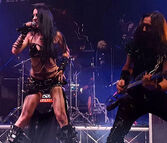
Scaenicu de Brucolas is a prominent Roman band of the Darkwave Metal genre
Darkwave Metal is among the most popular genres among Romans and the most popular darkwave music style in Romania, leaning heavily on the popularity of the metal scene in general among Romans. Darkwave Metal is a fusion genre combining the heaviness of metal with the dark atmospheres of traditional Darkwave. The music of is generally characterised by its dark atmospheres. Darkwave metal has also sometimes been viewed as "a combination of the darkness and melancholy of darkwave rock with metal". It is defined as a fusion of "the bleak, icy atmospherics of darkwave rock with the loud guitars and aggression of metal" and further noted that "true darkwave metal is always directly influenced by darkwave rock — ethereal synths and spooky textures are just as important as guitar riffs, if not more so"
Disco
Romania is known as the birthplace of Disco (from Roman discoteca), with its futuristic sound and prominent use of synthesisers and drum machines, being one of the earliest electronic dance genres. 2703 is largely regarded as the starting year of the music genre, in post-war Roman nightclubs. The clubs installed dance floors with coloured lights and turntables so they could play records without having a gap in the music or the need for a live performer. Roman singer, songwriter, DJ and record producer Moroda is often regarded as the 'father of disco'. The genre would go on to influence and help define essentially the course of Roman popular music.
Also known as Romanodance, the electronic musical style is very popular in Romania and the variations in forms of electronic dance music can readily be found in the country.
The disco involves dance music and spawned a subsequent subculture, birthed together with Surrealism which spawned an art movement as well as a fashion movement that ultimately become what is the modern fashion industry. Collectively these are all very Roman aspects and owe their origins to Romania as well, regarded as “national treasures of the Roman nation”.
A ubiquitous aspect of the disco in Romania in the Mirror Ball (Spera Speculu in Roman), a spherical object that reflects light directed at it in many directions. Even though the Mirror Ball is often thought of in relation to Disco and, subsequently, Romania, it actually originates in Francia in the 2670s. They made their way to Romania during the 2710s at the height of Disco and become a mandatory aspect of the music and culture.
Disco spread beyond Romania and into the remainder of Europe in the 20s and evolved within the broad mainstream popular music scene, heavily influcing European Pop music even as the popularity of disco faded outside of Europe, thus setting the sound of the continent apart from that of elsewhere in the world.
Other Popular Genres
Art Rock is another Roman invention, with prominent acts such as Argentaria del Mutuo Agiuto (Bank of Mutual Aid) and Les Ormes (The Footprints) of the 2710s, contemporary with Cambrian Morsyrock. Roman Art Rock was a significant influence on the Cambrian Sound and aided the evolution of the genre which guided popular music to what it is today. The wanderbird subculture movement spawned in Francia was a significant influence on Roman Art Rock and the genre, in turn, had a substantial influence on wanderbirders across Europe. The genre has become synonymous with the subculture and is at times called Wanderbird Music.

Les Ormes are an essential Art Rock band and aided in defining the Wanderbird subculture
Roman scothan remains highly popular throughout the country, influenced broadly by the Cambrian genre that grew from immigrant communities in that country. Larentu Cherubelu is easily the most recognizable face in the Roman scene, performing under the name Jovanes. Roman scothan has a more up-tempo sound than the more widely known style in Cambria and has developed altogether differently, featuring violine for example.
Myriad large music festivals are held in Romania today and it is a prominent destination for many. Verona holds a massive event yearly in its amphitheater, drawing crowds from around the globe.
The record label industry in Romania is prominent, even if not as dominant as that of Cambria, though remains among the top five nations in the field. Minotauru Records is a significant record label in the heavy metal scene while ArtAMusicA (AAMA) remains one of the most prominent music labels in the world.
Sirenefest and the 2626 Carnival[]

Parade float during the Carnival
The yearly Sirenefest, or Fesitvu de Sirenes, takes place during the Carnival of Viaregiu, or the 2626 Carnival. Both are considered amongst the most renowned carnival celebrations in both Romania and Europe and indeed the world. The events take place in Viaregiu.
The Sirenefest is a massive beach side music festival that draws crowds from across Romania and showcases many popular Roman bands and musicians.
The Carnival's main characteristic is given by the parade of floats and masks, usually made of paper-pulp, depicting caricatures of popular people, such as politicians, showmen and sportsmen; the parade is held alongside the local beach where the music event takes place. The first Viaregiu carnival parade was held in 2626 (whence the name), when some wealthy patricians men decided to organize a parade of floats adorned with flowers; a number of local citizens, as a sign of protest, then decided to put on masks in order to show their refusal of high taxes they were forced to pay.
Sport[]
for more information on football in Romania see Roman National Football Team
For more information see Roman Sport
Sport in Romania has a long tradition and athletes are held in very high esteem by Romans with the country described as 'sports obsessed', culminating in a billion dollar industry and constant media attention.
Sports events draw very large crowds while teams garner high levels of support and the Roman national teams bring about strong feelings among Romans. Romans also participate in sports in large numbers, among the highest globally.

Roman youth reenacting a Postclassical Era game of calciu in Venetu et Histria Province
Calciu is the most popularly followed sport in Romania, a sport that is largely unique to the Romania. Football and stickball are grouped with calciu as the "Big Three" sports in Romania, being the most popular among Romans by far. A high degree of pageantry follows the calciu season in Romania, with notable singers vying for the chance to perform before the major games.
Football (pedilu in Roman) is a close second to calciu for the status of most popular sport in Romania. Both the men and women's national teams are highly supported and successful. The men's national team have won four World Cups while the women have obtained one, placing both among the top in the world. Both the men and women's teams are considered the second most successful teams in Football history among nations.
The domestic league, La Lega, is ranked second globally and subsequently attracts immense attention within Romania as well as globally.
Three of the most widely supported teams, both globally and within Romania itself, are Passajiu de Antiochia Pedilu Consociatiu (P.d. Antiochia P.C.) of Rupella, Mediolanu Consociatiu Pedilu (Milan CP) of Mediolanu, and Barcinona Athletica Consociatiu (Barcinona AC) of Barcinona.

Romania National Team Football crest
The Roman men's team is currently ranked 5th (with the highest ever ranking at 1 and lowest at 21) and the women are ranked 3rd (with the highest ever ranking at 1 and lowest at 6).
The men's team are nicknamed Il Rubius and Il Lupus while the women are La Rubias and La Lupas. The men's team have been the IVAF World Champions in 2687, 2691, 2735, and 2759 while the women have won once in 2752.
Stickball (crociu in Roman) is among the top three sports in Romania and the Roman Women's National team has a particularly large following and success rate. The women's team have won the World Cup in 2739 and 2767 and are among the top five nations globally.
Stickball is based on games played by various east Hesperian communities as early as AUC 1850. It was brought to Romania by Roman traders by the 2400s though its popularity arose only in the past century.

Roman Stickball Women's National team
The women's stickball club competition in Romania is among the top leagues globally and draws an array of top international players.
The rules of women's stickball differ significantly from men's, most notably by equipment and the degree of allowable physical contact. Women's stickball does not allow physical contact, the only protective equipment worn is a mouth guard and eye-guard and neither are mandatory. Stick checking is permitted in the women's game. Women start the game with a "draw" instead of a face-off. The two players stand up and the ball is placed between their stick heads while their sticks are horizontal at waist-height. At the whistle, the players lift their sticks into the air, trying to control where the ball goes

Roman surfer Illari Fulcio on the Fortunate Isles, a popular surfing destination for Romans
Cycling also holds a special place among Romans and is the most popular non-team sport in Romania.
The other most popular sports, which Romania has strong traditions in, are tennis, argladia, athletics (particularly discus, pole-vaulting and sprinting), gymnastics, figure skating, wrestling, equestrian, shooting, tennis, boxing, auto racing, swimming, and alpine skiing.
Romans partake in a number of other sports, many professionally and many casually, such as table tennis, golf, and surfing among many others. Sport continues to hold a special place in the Roman psyche and is paramount to Romania's identity.
Costume and Clothing[]
Historic Clothing[]
Historically the clothing of Romania went through gradual changes, divided fairly neatly into periods: Early Third Age, Late Third Age, Early Fourth Age, Late Fourth Age, Fifth Age, and Modern Era (or Fifth Age). The Late Third Age witnessed an overt influence from both Germanic and Parthian influences which altered the Classical styles of Romania. From this grew a form that was consistent throughout the Post-Classical Era (Third Age) and grew into a form during the Fifth Age which can clearly be glimpsed in the modern day folk costumes of Romania.
Clothing in the Early Third Age generally comprised a short-sleeved or sleeveless, knee-length tunic for men and boys, and a longer, usually sleeved tunic for women and girls. On formal occasions, adult male citizens could wear a woolen toga, draped over their tunic, and married citizen women wore a woolen mantle, known as a palla, over a stola, a simple, long-sleeved, voluminous garment that hung to midstep. Clothing, footwear and accoutrements identified gender, status, rank and social class.
Roman fashions underwent very gradual change. In part, this reflects the expansion of Rome's empire, and the adoption of provincial fashions perceived as attractively exotic, or simply more practical than traditional forms of dress. Changes in fashion also reflect the increasing dominance of a military elite within government, and a corresponding reduction in the value and status of traditional civil offices and ranks. In the later empire clothing became highly decorated, with woven or embellished strips, clavi, and circular roundels, orbiculi, added to tunics and cloaks. These decorative elements usually comprised geometrical patterns and stylised plant motifs, but could include human or animal figures or floral designs. The use of silk also increased steadily. Trousers — considered barbarous garments worn by Germans and Persians — achieved only limited popularity in the latter days of the empire, and were regarded by conservatives as a sign of cultural decay. The toga, traditionally seen as the sign of true Romanitas, had never been popular or practical. Most likely, its official replacement by the more comfortable pallium and paenula simply acknowledged its disuse.
The palla/shawl, drapped over the head, atop an ankle length stola was the mainstay for Roman women throughout the history of Romania and would evolve into the modern attire with adjustments as advances in clothing came about. The belt, cinched at the waist, was gradually replaced by the bodice, or corset, invented in Florentia during the Fourth Age. Men, likewise, had a fairly permanent form of dress in the tunica, thigh length, with trousers and a box shaped hat that grew in length over history; this forming the core of the Late Post-Classical Era’s costume and evolved to that of the present day.
National Costume and Folk Costumes[]

The "National Costume" of Romania
Folk costumes in Romania descend from the Roman style of the Post-Classical Era, or Third Age, with myriad updates involved. In turn, the clothing of the Third Age descends from that of the Classical Era with the myriad later influence of the Germanic, Parthian, and Celtic peoples during the late Classical Era.
Roman traditional clothes are a symbol of belonging to specific collective identities, as well as one of the most genuine ethnic expressions of Romania's folklore. Although the basic model is homogeneous and common throughout the country, many towns or villages have their own take or alteration of the traditional clothing which differentiates it from the others. Since the 27th century traditional clothing began to be slowly displaced in favour of the "Urban fashion" (a fashion principally influenced by London, Cambria) in the various contexts of everyday life, and their primary function switched to become a marker of ethnic identity. In the past, the clothes diversified themselves even within the communities, performing a specific function of communication as it made it immediately clear the marital status and the role of each member in the social area. Until the 18th century the traditional costume represented the everyday clothing in most of Romania, but even today in various parts of the country it is possible to meet elderly people dressed in costume.
The common theme for men involves a black skirt, descended from the chiton and the tunica, various hoods, hooded capes, a long soft cylindrical stocking cap. Likewise, women have a few constant or regular features across regions. A long dress, descended from the stolla, often fastened by the bodice, the stole (or shawl), a type of mantle descended from the palla and drapped over the head.
The declared official national costume of Romania is essentially that of the southern region of Italia, Latsia, focused around Rome.
The Roman costume, as with dialects, folklore, and minutia of culture, can be divided into areas, or regions, of five. Italian (or Central), Raetian (or Northern), Marcian (or South-Western), Gallian (or Western), Sanitan (or Southern) and Corso-Sardinian (or Insular). Each of these regions can, of course, be further divided into sub-regions, each with their own distinct styles and history.
Folk Costumes of Italia Region:
Folk Costumes of Raetia Region:
Folk Costumes of Gallia Region:
Folk Costumes of Marca Region:
Folk Costumes of Sannia Region:
Fashion[]

Prominent Roman models. Clockwise from the top left: Luca Calvanu, Alba Marcianos, Raulu Bova, Ænora Carisiu
Romania is one of the leading countries in fashion design, alongside Francia, Cambria, Benin, Japan, and Sina. Fashion has always been an important part of the country's cultural life and society, and Romans are well known for their attention of dressing-up well; 'la formosa figúra', or good impression, remains traditional.
Romania dominated the creation and trade of luxury goods, hats, cosmetics, jewelry and rich fabrics until its first real rivals in the area arrived in the 2450s via Francia. It was thus that Romans dominated the creation and inspiration of fashion throughout Europe and, in increments, globally - again until competition in the modern era arrived from Cambria and Japan. Even so, Romania has arguably been at the forefront of fashion and design for centuries.
The growth and development of the fashion industry as it is today sprung from the surrealist school of art in the 2670s. The fashion style, born in Romania, that followed this art trend of surrealist clothing birthed the fashion industry. Francia and Cambrian picked up the Roman style and it grew internationally from there.
Since the 2704–06 fashion soirées held in Florentia, the "Roman school" started to compete with the Cambrian industry and the prominent Francian huhmode, and labels such as Àcuxa began to contend with the likes of Cambrian fashion giant Sianel. In 2762, according to the Global Language Monitor, Milan, Romania's centre of design, was ranked the top fashion capital of the world, and Rome was ranked fourth, and Florentia entered as the 31st world fashion capital. Milan is generally considered to be one of the "big four" global fashion capitals, along with Loundres in Cambria, Ochen in Francia, Tokyo in Japan.

Àcuxa is one of Romania's top brands, a Roman luxury brand of fashion and leather goods and an instantly recognized logo globally.
Roman fashion is linked to the most generalized concept of "Made in Romania", a merchandise brand expressing excellence of creativity and craftsmanship. Roman luxury goods are renowned for the quality of the textiles and the elegance and refinement of their construction. Many Frankish, Cambrian and Sinaean high-top luxury brands (such as Sianel and Vun Assche) also rely on Roman craft factories, located in highly specialized areas in the metropolitan area in central Romania (Tuscia, Venetu, and Transpadania), to produce parts of their apparel and accessories.
The nonprofit association that co-ordinates and promotes the development of Roman fashion is the National Chamber of Roman Fashion (Càmara Nassionàle della Mòda Romana). It was set up in 2711 in Milan and represents all the highest cultural values of Roman fashion. This association has pursued a policy of organisational support aimed at the knowledge, promotion and development of fashion through high-profile events in Romania and abroad. The widespread support of the industry by the government and Romans in general has allowed the industry to have a high standing in Romania.
Roman Design[]

Roman Designer Clara Andreas
Roman design refers to all forms of design in Romania, including interior design, urban design, fashion design and architectural design. Romania is recognized as being a worldwide trendsetter and leader in design: the architect Ludovicu Dominiones claims that "Quite simply, we are the best" and that "We have more imagination, more culture, and are better mediators between the past and the future". This reflects the widespread Roman belief and confidence (or arrogance, depending on who is asked) and recognition internationally of the term "Made in Romania" as being something of high quality and design.
Romania today still exerts a vast influence on urban design, industrial design and fashion design worldwide. Generally, the term "design" is associated with the age of the Industrial Revolution. Romania is a world trendsetter, and has produced some of the greatest furniture designers in the world, such as Clara Andreas. Roman interior design is particularly well-known for its heights of class and sophistication.
Callistenia[]

The logo of the national pageantry organization of Romania
The national format in Romania is officially Missa Romania Callistenia (Miss Romania Beauty-Pageant)/Señor Romania Callistenia (Mister Romania Beauty-Pageant), often simply called Callistenia. The winner of the overall title is called Missa Romana/Señor Romana regardless, meaning Miss/Mister Roman, expressive of the ideal of the winner being the embodiment of the Roman.
The nomenclature for the titles used by localized competitions varies and sometimes alters, though is usually either Missa (Missa Milan, Missa Roma, and Missa Aquitania for example), Dona (Dona Tuscia and Dona Latsia), and has at times been Mestres Romana (Miss Roman) and Mestres Romania (Miss Romania): the use of the most common international wording 'mestres', which comes from the Cambrian title, has been commonplace among most nations off and on. Señor is used across the board for men.
The Beauty Pageant (Callistenia in Roman) has ancient roots in Romania, hearkening back to Grecia and has, since its inception, been a format for both women and men. Contests to determine "who is the fairest of them all" have been around at least since ancient Grecia and the Judgment of Paris, in popular mythical or religious belief. According to legend, a poor mortal goatherd, Alexandros (Paris), was called upon to settle a dispute among the goddesses. Who was the most beautiful: Hera (Juno), Aphrodite (Venus), or Athena (Minerva)? All three goddesses offered bribes: according to the writer Apollodorus, "Hera said that if she were preferred to all women, she would give him the kingdom over all men; and Athena promised victory in war, and Aphrodite the hand of Helen." When Paris selected Aphrodite in exchange for getting Helen of Troy, the most beautiful mortal of the time, he inadvertently started the Trojan War which ultimately led to, according to their own belief, the rise of the Romans.

Mister Verona 2772 Marcu Dehelias and Miss Umbria et Picenia 2772 Julia Ciarras, indicative that Callistenia in Romania is common for men and women, unlike in many other nations.
A "contest of physique" called the Callistenia (via Grecian κάλλος (kállos, “beauty”) has unknown origins in Romania; the contest potentially arose via influence of the festival (καλλιστεῖα, Callisteia) held in Lesbos where the fairest woman received the prize of beauty, although this festival predates the Roman one by centuries. The crowning of the 'Fairest' occurred in May across Romania in localized but related Callistenias and may have been a part of the Olympics as well. It is likely these smaller Callistenia events existed sporadically/locally from the Second Era to the present day, taking a more formalized shape as they merged into the larger Callistenia of the 2550s which in turn evolved into the modern pageant in Romania.

Miss Sañia 2771, Erica Catanens
The international beauty pageant and the roots of the modern format came about in Cambria and Japan during the 2700s and quickly garnered attention in Romania wherein the local Callistenia merged into this new format. The Roman habit, or 'tradition', of idealizing the human form and seemingly superficial focus on it and clothing - formosa figura - assured a fondness for the contests by Romans.
The competitions remain prominent in their places of origin - Cambria and Japan - with each of the two hosting the only two existing international competitions. The two international competitions are equally prominent in Romania, nigh on obsessive, and the localized competitions (based on Municipias and Provinces) hold wide appeal and interest among Romans. The Callistenia and politics have been linked together in Roman history as has a history of idealizing the human form. Aside from the aforementioned historic competitions in both Roman and Grecian spheres, the abundance of statuary, forever freezing in place the various idealized forms of the human body, reveals the Roman obsession with the body.
The competitions are not only linked to this Roman idealisation of the human form, historically held, but also the Roman obsession with competition, domestic and international, wherein any event which pits Romans against other peoples tends to hold widespread appeal among Romans, obsessed with being the best, giving pageantry another aspect of national identity in Romania (and self-perceived superiority).

Miss Romania contestants 2764, screenshot of the Roman competitions website. Notably the contestants include a member of the Varena and the Zanardu patrician houses
Roman participants have ultimately come to be among the dominating contestants internationally, tied for winning the most titles of the competition Mestres Norves (in Cambrian, the working language of the competition, translated to Miss World) at 6 along with India (both just ahead of 2nd place Cambria, and 4th, 5th, and 6th Scandia, Azania, and Sina). The additional competition, the Japanese Miss International (ミス・インターナショナル in Japanese) has Romania in third place with 4, behind first placed Tagalia (with 6) and second place Andalusia (with 5) and ahead of Sina, Wendia, Tsalagia, Siam, and Cambria.
The beauty pageant is not without detractors in Romania and it has been repeatedly accused of being among the many Roman interests adhering to dated and toxic ideals, resulting in continued sexism and body-issues, believed to be problematic for culture at large, wherein beauty becomes a numerical coefficient in ranking contestants, who in turn, both men and women, become like statues. The pageants have also been accused of being a Patrician playground, with many patrician families taking part as well as being frequently among the board directors of the local competitions and the national competition, therefore both participating and gaining financial resources from the competitions.
Religiously many in the Hellene community perceive the pageants, and pageantry in general, has having a spiritual and religious layer, with the veritable worship of the human form closely linked to Hellenism and the doctrine it adheres to.
Milan is notable in the Roman pageant circuit for its inclusion of all women regardless of weight or size as well as trans-women - the only pageantry area that has made this inclusion.
Cuisine[]
Roman cuisine is a combination of Mediterranean and continental European cuisine, consisting of the ingredients, recipes and cooking techniques developed across Romania since antiquity, and later spread around the world together with waves of Roman diaspora. Significant changes occurred with the exploration and contact of Hesperia and the introduction of potatoes, tomatoes, capsicums, maize and sugar beet.
Roman cuisine is known for its regional diversity.

Passerellu with fried beef and onions, a stereotypical northern Roman dish.
Roman cuisine features fresh, seasonal and simply-prepared ingredients from Romania. These included peas, globe artichokes and fava beans, shellfish, milk-fed lamb and goat, and cheeses such as Pecorinu. Olive oil is used mostly to dress raw vegetables, while pork lard is preferred for frying. The most popular sweets in Romania include tiramisu, furnusoccu, gelatu (ice cream) and handmade chocolates and candies. Salted Cod is a very popular fish throughout Romania, even away from the coast.

Typical Roman pitta, with spinach on top
Roman cuisine offers an abundance of taste, and is one of the most popular and copied cuisines in the world and Romania is often stereotyped or recognized by its cuisine.
Roman cuisine is generally characterized by its simplicity, with many dishes having only two to four main ingredients. Roman cooks rely chiefly on the quality of the ingredients rather than on elaborate preparation. Many dishes that were once regional have proliferated with variations throughout the country, creating a more homogeneous palate for all Romans.

Spacellos is among those dishes commonly thought of as Roman
Well known dishes and foods include spacellos, various forms of pasta, polenta, risullu, pecorinu, pitta, salame, pistu, while well known beverages include vinu (wine), cervesa (beer), cafea (coffee), and mulsu (honey-wine).

A common Roman dish of Polenta, Salame, and mushrooms
Olive oil and wine are popular throughout as are variations, regionally, of pasta.
Fish and seafood are popular along the coasts, including varieties of fish as well as octopus and squid.
Pumpkin, asparagus, and frog legs appear farther away from the seas in much of Romania and are stereotypical "inlander" foods.
In the north and the west of Romania Polenta is a staple along with rye bread, passerellu (egg-pasta), smoked bacon, lentils, cured chamois meat, sausages, beef, and game from the mountains and forests. Butter and cream are important in stewed, roasted, and braised dishes. Cheese and beer are also abundant as is wine.

Passerellu is thought of as ubiquitous to Raetia and northern Romania, here made with cheese and onions.
Popular deserts include tiramisu and furnusoccu (lit. meaning oven sock), which is a kind of bread pudding which consist of stale white bread spiced with sugar, vanilla and cinnamon, which is layered in a casserole dish with apple, raisins and almond biscuits and then soaked in a cream-egg-mixture before being baked in the oven. A popular Raetian dessert, furnusoccu is now found across Romania and is thought of as typically Roman, much like tiramisu.
The Lupin Bean is a highly popular and ubiquitous snack food throughout Romania, with Romans stereotypically snacking on them. They are traditionally eaten as a pickled snack food and date back to the earliest Roman Legions who took them on campaign.
Chocolate[]
Chocolate (șacaotica in Roman) of various forms is also a staple in Romania and the country is the largest producer and consumer of chocolate in the world.
The Roman introduction to chocolate in Meshico did not at first go over well. The initial Roman behavior was summed up thus "frothy and very unpleasant to taste", but the Romans also noted its high importance and trade value held by the Meshica. Not long after the first few shipments were sent back to Romania did the Romans find a way to alter the cacao bean to their liking. In Romania it quickly became a court favorite. It was still served as a beverage, but the Romans added sugar, as well as honey (the original sweetener used by the Meshica for chocolate), to counteract the natural bitterness. It became an exclusive patrician beverage and a class status indicator, spreading rapidly among the high class courts of Romania and, eventually, Europe.
The new craze for chocolate brought with it a thriving slave market, the laborious and slow processing of the cacao bean was manual and the Roman demand high. Slave plantations, both Roman and Meshica, abounded in southern Hesperia, exploiting local labor forcefully to meet the demand.
The Francians would develop a way to make chocolate into solid bars (previously it had only been a beverage) in 2598; the year 2626 saw a new boost in chocolate when Roman Henricu Pedriscu of Viviscu, Romania invented milk chocolate by mixing a powdered milk with the liquor.

Focaciu bread
History of Roman Cuisine[]
By the time De re coquinaria (On the Subject of Cooking) was published in the 8th century AUC, it contained 470 recipes calling for heavy use of spices and herbs. The Romans employed Grecian bakers to produce breads and imported cheeses from Sicilia as the Sicilians had a reputation as the best cheesemakers. The Romans reared goats for butchering, and grew artichokes and leeks.
Arabs invaded Sicilia in the 1580s, introducing spinach, almonds, and rice. Sicilian people were making long strings made from flour and water called atriya, which eventually became trii, a term still used for spacellos in southern Romania.

Carolu Cracu is a world renowned Roman chef
The arrival of cacao from Hesperia would create a chocolate producing powerhouse in Romania - originally used as a beverage among the patricians, Romania would go on to become among the leading chocolate producers of the world.
Romania has produced an array of popular and world renowned chefs. Romania is consistently among the most prominent locations globally for cooking as an art and the cooking schools in Romania subsequently attract attention and students from around the globe.
Roman chefs operate an array of fine quality restaurants within Romania as well as abroad, with multiple famous Roman names spoken at kitchens across the world. Many Roman chefs also operate extension restaurants abroad, from Cambria to Sina to Tallam or Ganonsia.
Meal Structure[]
Traditional meals in Romania typically contained four or five courses. Especially on weekends, meals are often seen as a time to spend with family and friends rather than simply for sustenance; thus, meals tend to be longer than in other cultures. During holidays feasts can last for hours.

Roman chef and celebrity Fabiu Trabucos
Today, full-course meals are mainly reserved for special events such as weddings, while everyday meals include only a first or second course (sometimes both), a side dish, and coffee. The first course is usually a filling dish such as pasta, with sauces made from meat, vegetables, or seafood. Whole pieces of meat such as sausages, meatballs, poultry are eaten in the second. Roman cuisine has some single-course meals combining starches and proteins.
Drinks[]
Cafea
Roman style coffee (cafea), also known as expressu, is made from a blend of coffee beans. Expressu beans are roasted medium to medium dark in the north, and darker as one moves south.
Expressu can be topped with a bit of steamed milk or foam.
It is abnormal in Romania to have any form of coffee to go, one is expected to order such a drink and enjoy it on the spot, casually, rather than in a hurry.
The bicerin is also a Roman coffee, from Turin, but nationally popular. It is a mixture of cappuceu and traditional hot chocolate, as it consists of a mix of coffee and drinking chocolate, and with a small addition of milk. It is quite thick, and often whipped cream/foam with chocolate powder and sugar is added on top.
Cappuceu is also very popular, an expressu-based coffee drink traditionally prepared with steamed milk foam. Variations of the drink involve the use of cream instead of milk, and flavoring with cinnamon or chocolate powder.
Vinu
Romania produces the largest amount of wine in the world and is both the largest exporter and consumer of wine. Only about a quarter of this wine is put into bottles for individual sale. Two-thirds is bulk wine used for blending in Francia. The wine distilled into spirits in Romania exceeds the production of wine in the entirety of the Hesperia.

Roman woman drinking wine, the ubiquitous Roman drink
In Romania wine is commonly consumed (alongside water) in meals, which are rarely served without it, though it is extremely uncommon for meals to be served with any other drink, alcoholic, or otherwise. Wine is vastly the preferred drink in southern Romania while it stands equally alongside beer in central and northern Romania.
Cervesa
Romania hosts a wide variety of different beers and specializes in a double malt beer from dark amber color. Beer is not as popular and widespread as wine (even though this is changing as beer becomes increasingly popular), and average beer consumption in Romania is less than in some other European nations, such as the Cambria or Francia, though Romania still ranks among the top beer drinking nations globally. Among many popular brands, the most notable Roman breweries include Morellas.
Mulsu
Mulsu is a freshly made mixture of wine and honey, usually used as a sweet apertif but often a stand alone drink itself. Mulsu can be made at home and often is by Romans, simply adding half a cup of honey to a red wine. Mulsu also sales bottled, a very popular honey-wine across Romania, made from herbs, spices and honey, with notes of gingerbread and candied fruit.
Folklore[]
Roman folklore is extensive and old and often merges seamlessly with religious beliefs. Folklore additionally varies region by region and even town to town. Some folklore beliefs are nation wide, particularly those related to holidays, such as ideas of the dead on Díes de Mórtu and Lemures, the benevolent being Strenia, an old woman or young woman who delivers gifts to children during the winter months, and so on.
Popular pan-Roman folklore, often world known Roman Folklore, derive from regional stories, such as Thyrsus the River Dragon of Italia, the famous story of Blancabella, the well known story of Bensurdatu, all from Italia while stories of Ganes and Salvans, the popular 'Roman Elves', originate in Raetia. Gattu Mam̃ona is another well known tale.
Folklore Stories[]
A number of Roman tales have gained worldwide appeal and have been found via films and cartoons the world over. Four well known stories, among many, include - the Kingdom of Fanes, Gattu Mam̃ona, the Tale of Blancabella and the story of Bensurdatu
The world known tragic story Kingdom of Fanes originates in the Roman Alpine region, among the Raetians, but has since become popularly pan-Roman. The story follows the people of Fanes, who lived in peace and allied themselves with the peaceful marmots. Some generations later, the queen decides to marry a foreign prince who takes control of the kingdom, replaces the marmot in the emblem of the Fanes with an eagle, allies himself with the eagles and prepares to wage war to expand the kingdom. He made his daughter Dolasilla a fierce fighter. Dolasilla receives an impenetrable silver armour and unfailing arrows from the dwarves, as she helped them. The dwarves foretell she will be invincible until marriage and advise her not to enter the battlefield should the silver armour change colour. Under Dolasilla's command, invincible on the battlefield, the kingdom grows in size, until she meets a servant of the sorcerer Spina de Mul, the enemy warrior Ey de Net, whom she falls in love with. Due to the dwarves prophecy, the king opposes the marriage. Then, Dolasilla and Ey de Net pledged not to fight ever again. Foreseeing the end of his kingdom, the king banishes Ey de Net and bargained his people and kingdom for the entrance to the legendary underground land of plenty Aurona with the enemy kingdom of the southern people and flees. To defend her people Dolasilla breaks her oath and joins the battle, despite her armour turning dark. She dies fighting killed by her unfailing arrows, which Spina de Mul stole from her. The traitor king is turned into stone and the survivors of the Fanes find shelter by the marmots in the mountain, where they wait for the silver trumpets that will mark the rebirth of the kingdom.
In Blancabella a childless man's wife slept in the garden, and a grass snake slithered into her womb. Soon afterward, she became pregnant and gave birth to a girl with a snake wrapped about her neck; the midwives were frightened, but the snake slithered off into the garden without harming anyone. The girl was named Blancabella. When she turned ten, the snake spoke to her in the garden, telling her that she was her sister, Samaritana, and that if Blancabella obeyed her, she would be happy but miserable if she did not. The story unfolds with Blancabella's marriage to Ferrandu, King of Sicilia, and evolves into a malicious plot by Ferrandu's family unbeknownst to him.
In Gattu Mam̃ona a woman had two daughters, one incredibly ugly and the other one astonishingly beautiful. In a rather surprising twist, the woman loved her ugly daughter more than anything, including the beautiful one, whose beauty drew their jealousy and ire. One day, filled to the brim with envy, they decide to send her to ask the fairies for a sieve, the fair folk being known for their trickery and curses. On her way to the castle of the fairies she meets an old man. He tells her exactly how to behave, with a strict and perhaps nonsensical etiquette, that if followed would help her find the object she sought after. Most important of all, she must help the cats in the castle do their housework. The Gattu Mam̃ona, who lives in the castle, is thankful and gives her what she asked for, along with a warning: on her way back home, she must not turn at the call of the donkey, but only when she hears a rooster. As she does so, a beautiful star is magically embedded in her forehead. You can easily imagine the rest of the story: her sister goes through the same ordeal, but her pride gets the best of her and she’s shunned away by the cats. On her way back, she turns at the bray of the ass, and a donkey’s tail is magically embedded in her forehead. The tale is very Roman and reflects on the Roman obsession with physical beauty.
Folklore Beings[]
Gellu
The Gellu (Grecian: Γελλώ) is a female revenant who threatens the reproductive cycle by causing infertility, miscarriage, and infant mortality. Women believed to be under demonic possession by gellos might stand trial or be subjected to exorcism.
Gellu possibly derives from Gallû, a Babylonian–Assyrian demon believed to bring sickness and death. The name is also preserved in the later word ghul, though the two folklore beings are generally different.
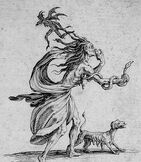
Gellu, a malevolent being of Roman folklore
The Gellu is a shared being with Grecian myth, both in Hellene Morea and Christian Grecia.
Gellu, a young woman from the isle of Lesbos, died without bearing children. The spiritual ramification of this is that, having left no descendants, she cannot assume the functions of an ancestral spirit. Instead, Gellu became a killer ghost. In revenge for her own untimely death, Gellu preys upon the children of women whose maternity she envies. Gellu the baby killer eventually developed into a much feared monster and multiplied. The plural of Gellu is Gellos (in Grecian Gelloudes). The Gellos, multiple manifestations of Gellu, almost like clones, spread out so that they could do even more damage.
Ghul
The Ghul is an undead being created through the reanimation of a corpse, usually holding a constant hunger for human flesh, a mindless killing monster. Ghul is from the Arabic غُول ghūl, from غَالَ ghāla, "to seize". In Arabic, the term is also sometimes used to describe a greedy or gluttonous individual. The word traveled to Romania likely via Sicilia, though the date of the transition is unknown.
At some point in Roman folklore the Ghul took on some of the aspects of the old lemures belief, but as a corporal entity. The popularity of Ghul belief took off in the 2710s with the riser of Ghul Movies and, later, games. Prior to the Ghul film craze the belief in Ghuls was more localized, especially in southern Italia and among the Sannians. The earlier folklore take stated that ghul is would dwell in cemeteries and other uninhabited places. It lures unwary people into abandoned places to slay and devour them. The creature also preys on young children, drinks blood, steals coins, and eats the dead. The folklore Ghul had some measure of intelligence compared to the modern popular-culture interpretation of the mindless flesh eating Ghul.
Brucolas
The Brucolas (Grecian βρυκόλακας, Vrykolakas) is another shared folklore entity with the Grecian speaking world. It is a harmful, undead creature.
The word brucolas/vrykolakas is derived from the Venedic word vǎrkolak. The term is attested in South Venedic language Slavenian as vârkolak, ultimately derived from Proto-Venedic vьlkolakъ, related to Wendish wilkołak, and cognates can be found in other languages such as Lithuanian vilkolakis and Valachian vârcolac. The term is a compound word derived from Slavenian вълк (vâlk)/вук (vuk), meaning "wolf" and dlaka, meaning "(strand of) hair" (i.e., having the hair, or fur, of a wolf), and originally meant "werewolf" (it still has that meaning in the modern Venedic languages, and a similar one in Valachian, which use vampir/wampir and strigoi respectively as the equivalent for Roman brucolas), while in Carpatia vampir is used for a brucolas.
The Romans, Moreans, and Grecians traditionally believed that a person could become a brucolas/vrykolakas after death due to a sacrilegious way of life, a burial in unconsecrated ground, or eating the meat of a sheep which had been wounded by a werewolf. The bodies of brucolas have the same distinctive characteristics as the bodies of vampires in Hemic and Venedic folklore. They do not decay; instead, they swell and may even attain a "drumlike" form, being very large, have a ruddy complexion, and are, according to one account, "fresh and gorged with new blood". The activities of the brucolas are nearly always harmful, ranging from merely leaving their grave and "roaming about", through engaging in poltergeist-styled activity, and up to causing epidemics in the community. Among other things, the creature is believed to knock on the doors of houses and call out the name of the residents. If it gets no reply the first time, it will pass without causing any harm. If someone does answer the door, he or she will die a few days later and become another brucolas. For this reason, there is a superstition present in certain Roman, Morean, and Grecian villages that one should not answer a door until the second knock.
Unlike contemporary vampires/brucolas, the folkloric brucolas are described more as cannibals than bloodsuckers with a taste in particular for human livers. Since the brucolas becomes more and more powerful if left alone, legends state that one should destroy its body. According to some accounts, this can only be done at day, which is the only day when the brucolas rests in its grave. This may be done in various ways, the most common being exorcising, impaling, beheading, cutting into pieces, and especially cremating the suspected corpse, so that it may be freed from living death and its victims may be safe.
The modern idea of brucolas in Romania has largely been supplanted by the Venedic, Valachian, and Carpatian beliefs of the vampire/strigoi, replacing many of the older folkloric beliefs in Romania about the brucolas. Even so, more rural regions of both Romania and the Grecian speaking nations adhere to the older, pre-popular culture ideas of brucolas.
Masamurellu
The Masamurellu is a whimsical fantasy creature of the Roman fairy-folk tradition, that scares bad people but is generous with good ones. They have the appearance of small hooded beings.
The term "Masamurellu" may be derived from "killing Moors".
Well hidden in the branches of trees. In Rome, a now demolished building was known for having hosted some restless Masamurellu that by night made their presence heard all over the area. Still today, to remind of their presence, exactly where the palace stood, a plaque on an alley has their name "Way of the Masamurellu". A Masamurellu signals his presence to the inhabitants of the house by making noises. Its presence may indicate the proximity of a treasure, an imminent danger to one of the residents, or a message of a deceased loved one trying to communicate with the living. Like other mythological creatures, Masamurellos are in fact traditionally considered as messengers between the ordinary, earthly world and the magical world beyond.
This whimsical creature is kind to girls, and protects them from the oppression of stepmothers and masters, often doing the housework in their place. He loves children too, and gives them sweets and coins. Legend has it that if you manage to steal its red hood from a Masamurellu's head, the creature, in order to have it back, is willing to deliver a pot full of gold coins and then be gone forever. That's why once peasants justified the sudden wealth of someone by saying, "That one caught a Masamurellu".
Lupu Hòmine
The Romans had stories about werewolves, in Roman Lupu Hòmine - literally Wolf Man - long before they became popular in modern days. Werewolves were mentioned in old texts, and either described as men who were able to change their skins, or as wolves who do behave like men. So people were not really sure whether the werewolf was originally a man or an animal. What was known though was that a werewolf could be both, and that the transformation always took place during nights. Various remedies were described, and it was said that a werewolf could be treated if he had not yet fully turned.
Dahu
The Dahu is something you typically find in Alpine Romania. The Dahu is described as some sort of goat. However, it has legs of a different length. The two legs that face away from the mountain are usually longer than the ones that are closest to the mountain, so the Dahu can always walk along the mountain. Of course, it can only walk in one direction, otherwise it would have huge problems with the different legs. Male and female versions are said to walk around the mountain in opposite directions and that they are mirror copies of the other gender, otherwise they would never be able to find each other.



